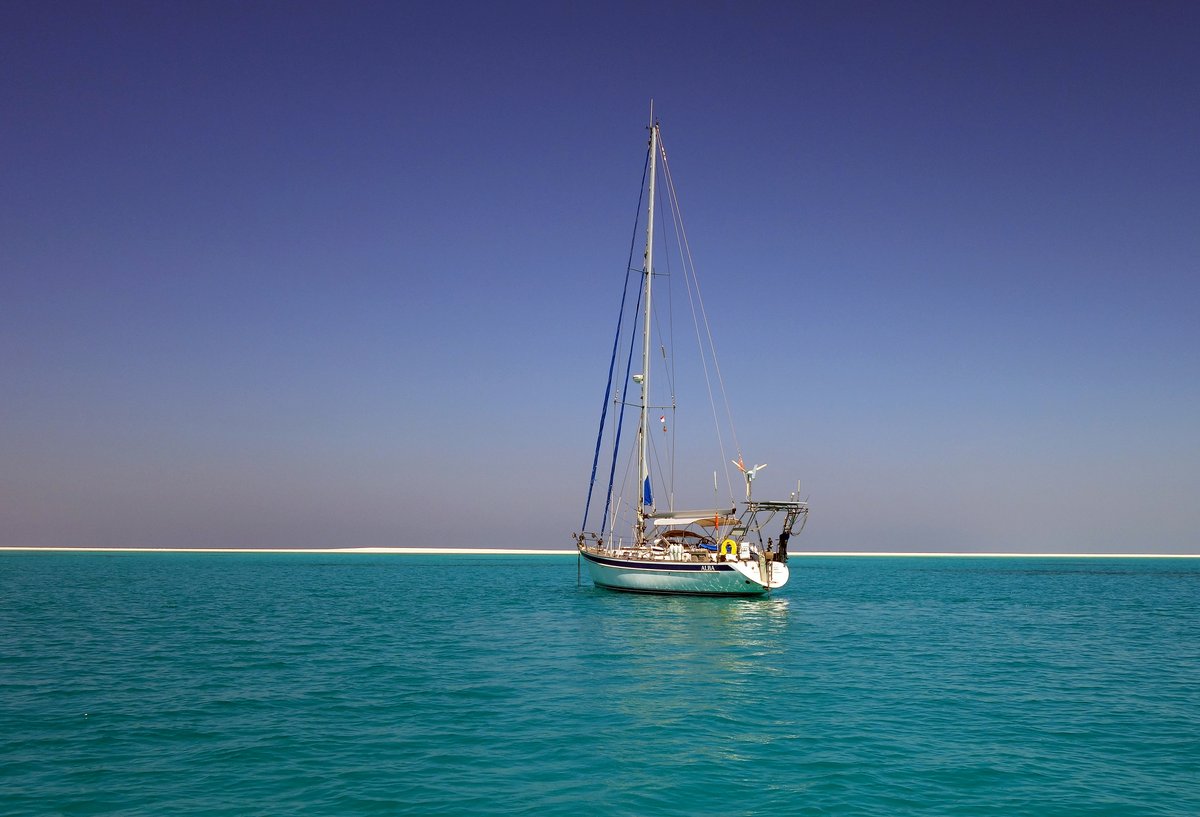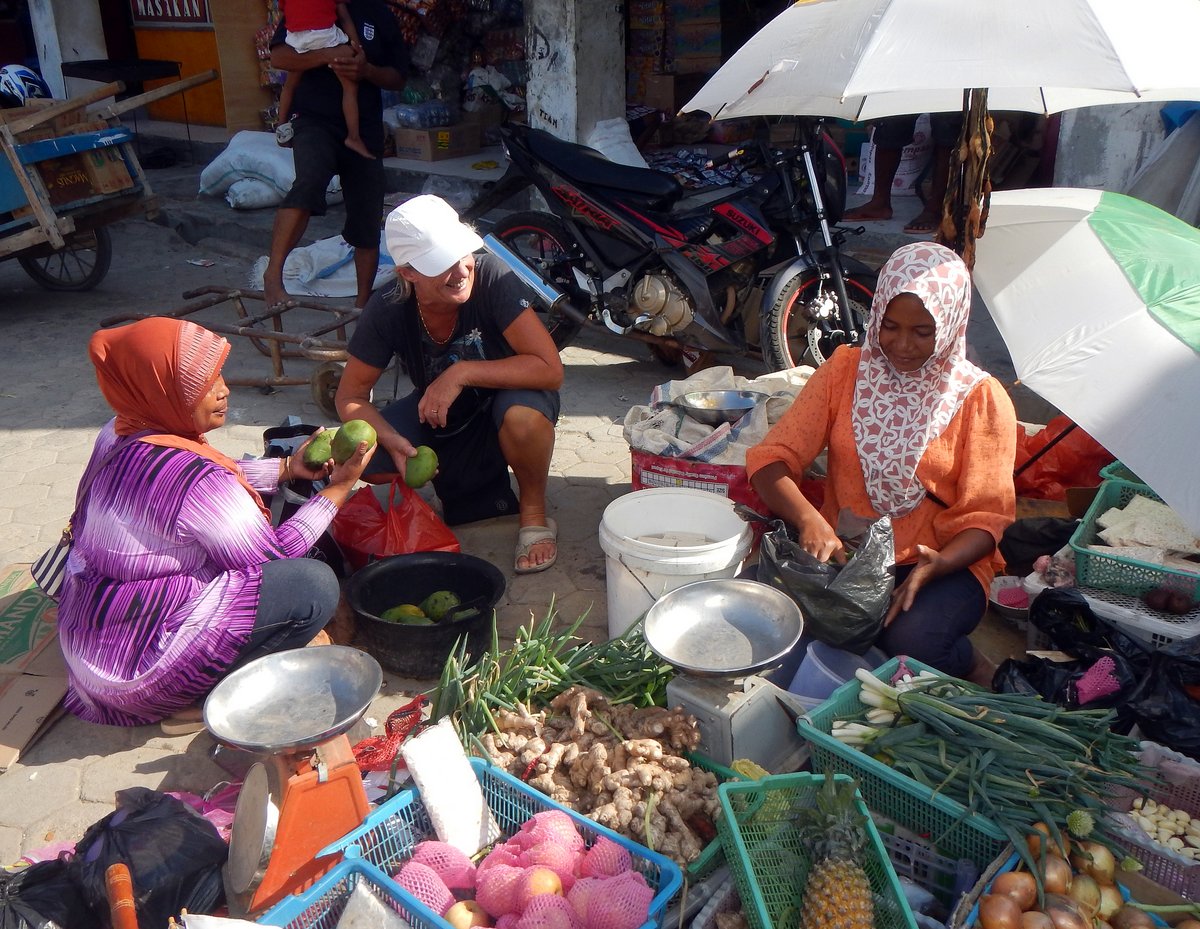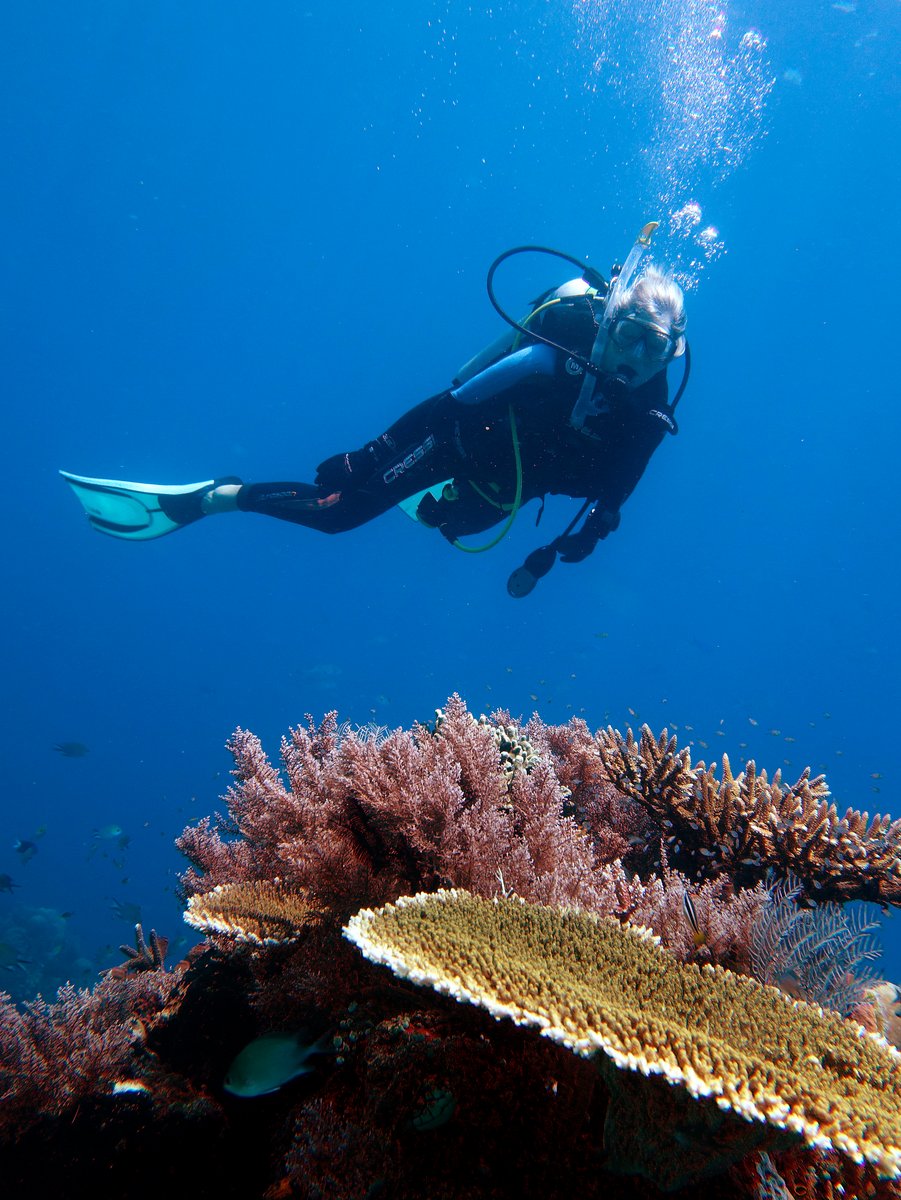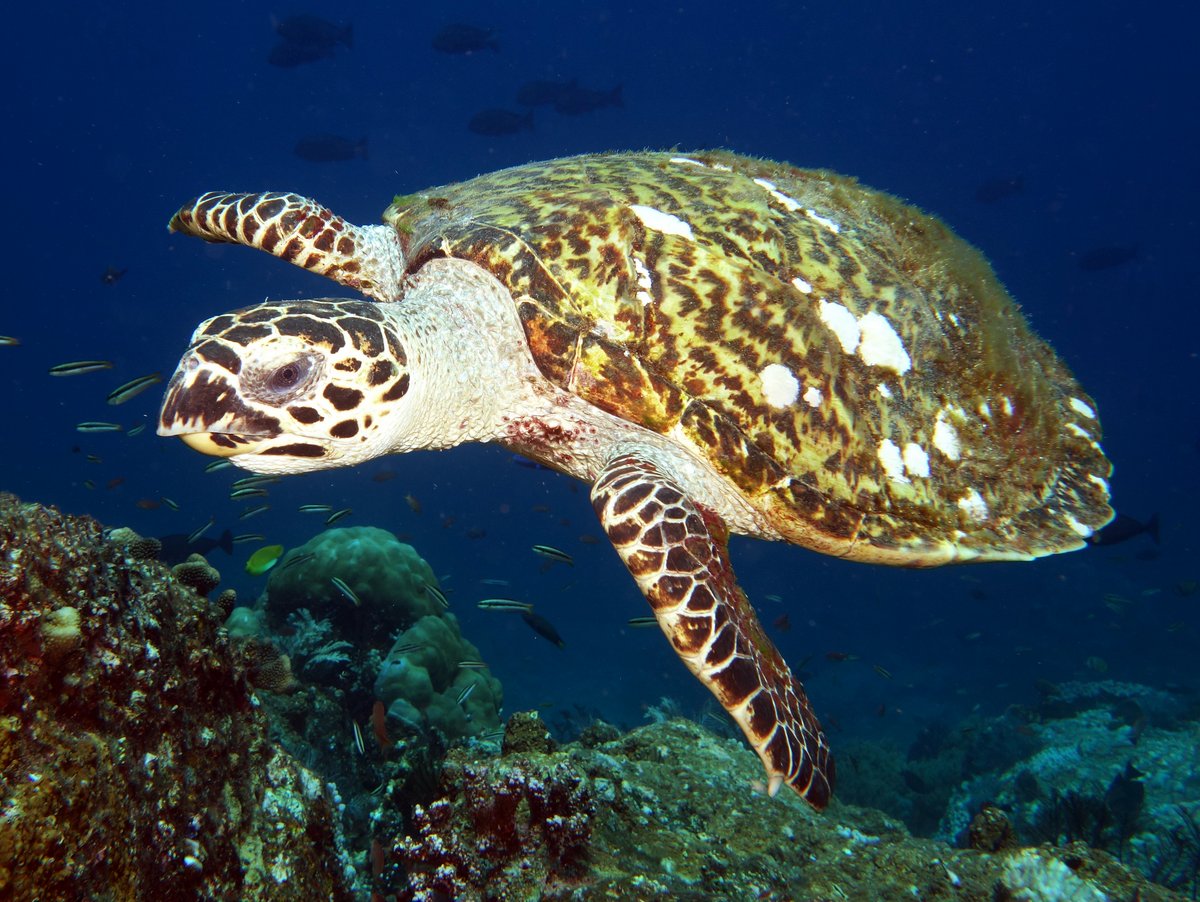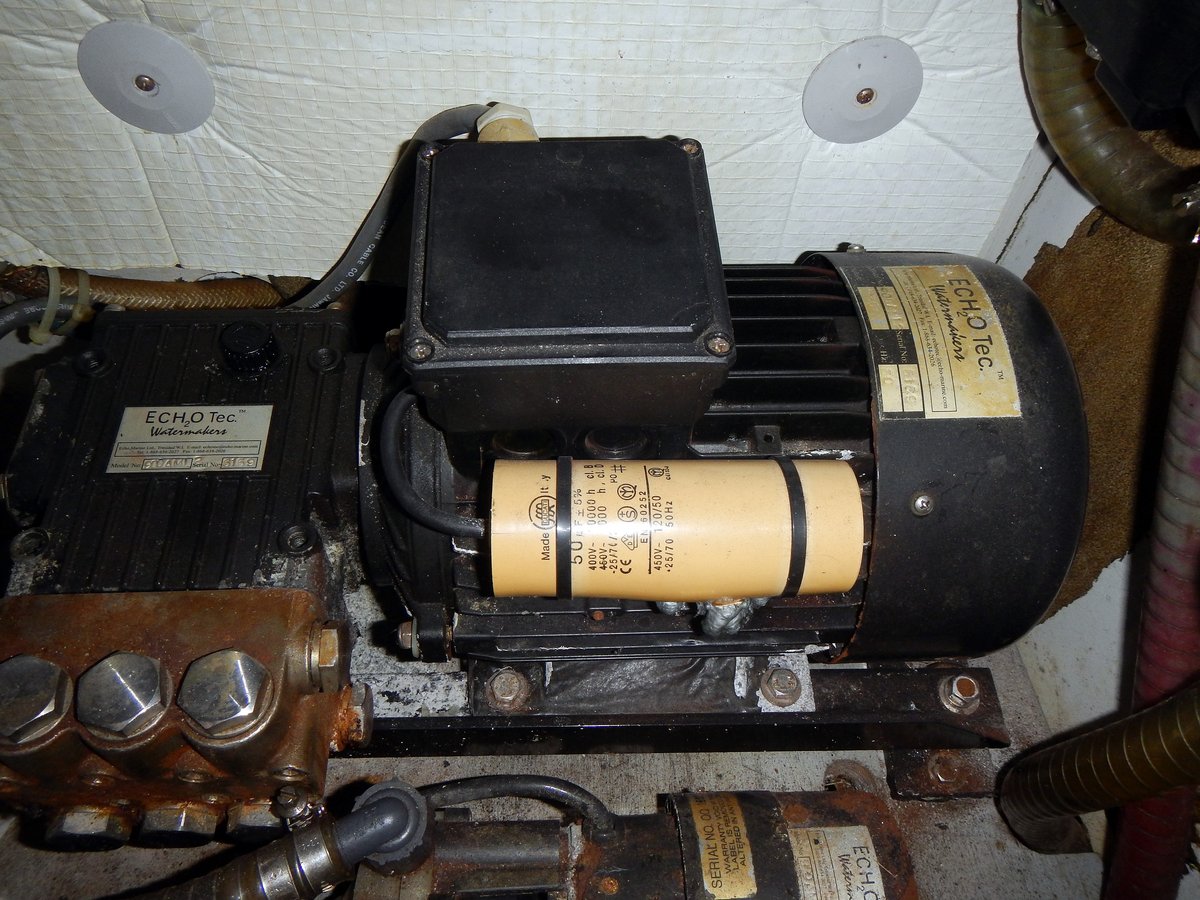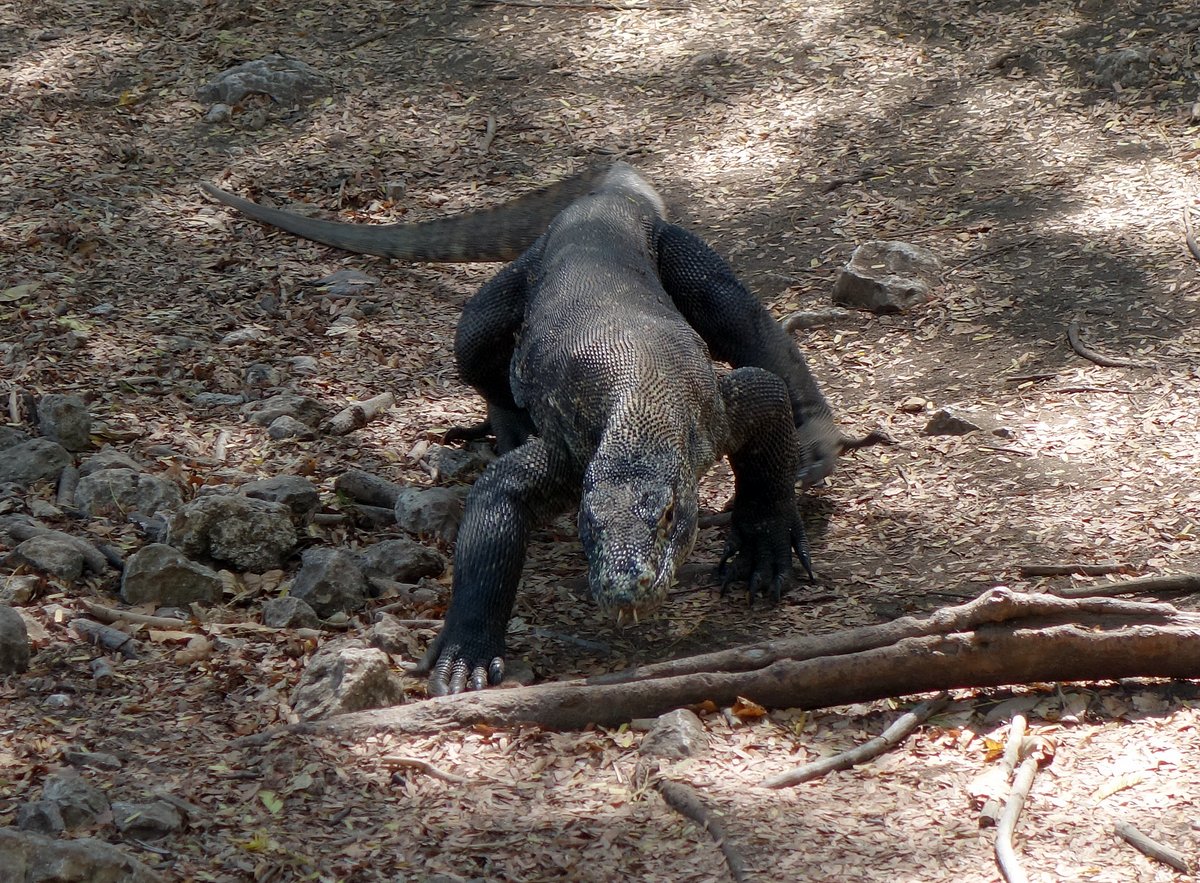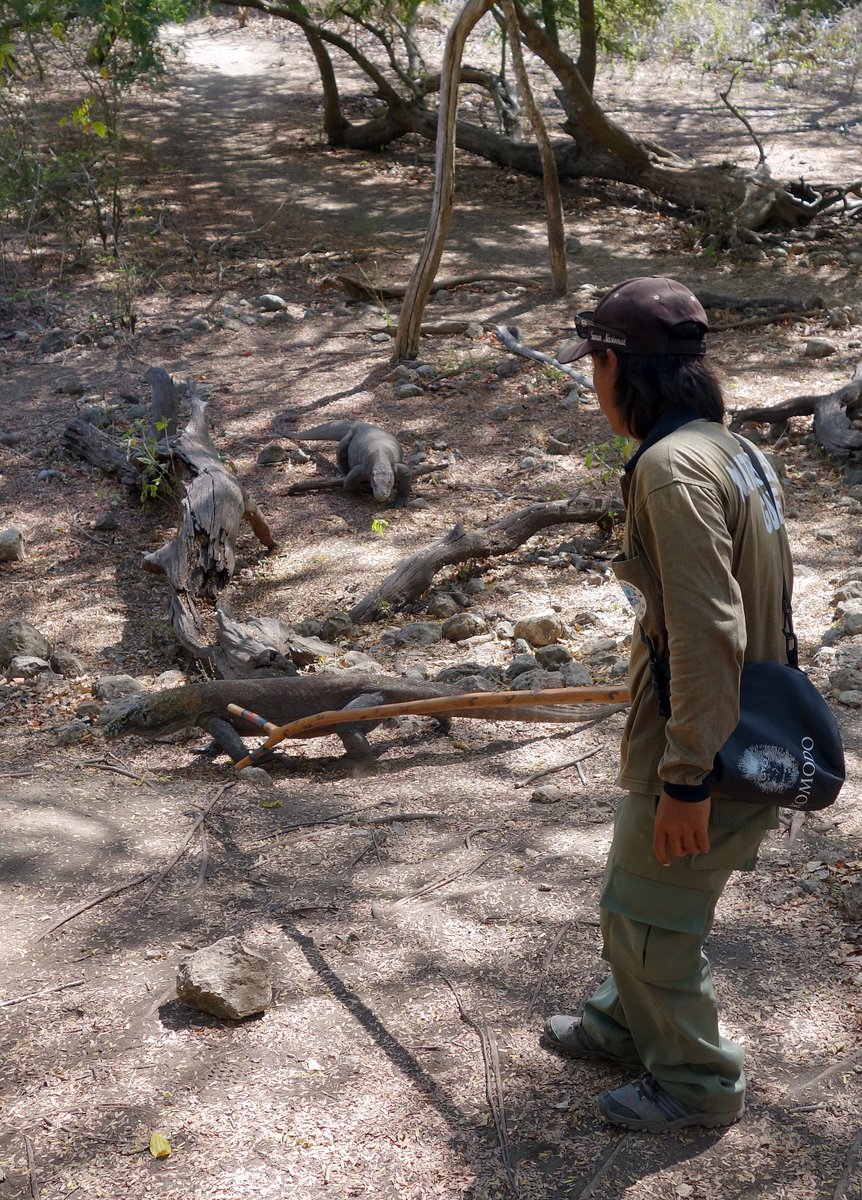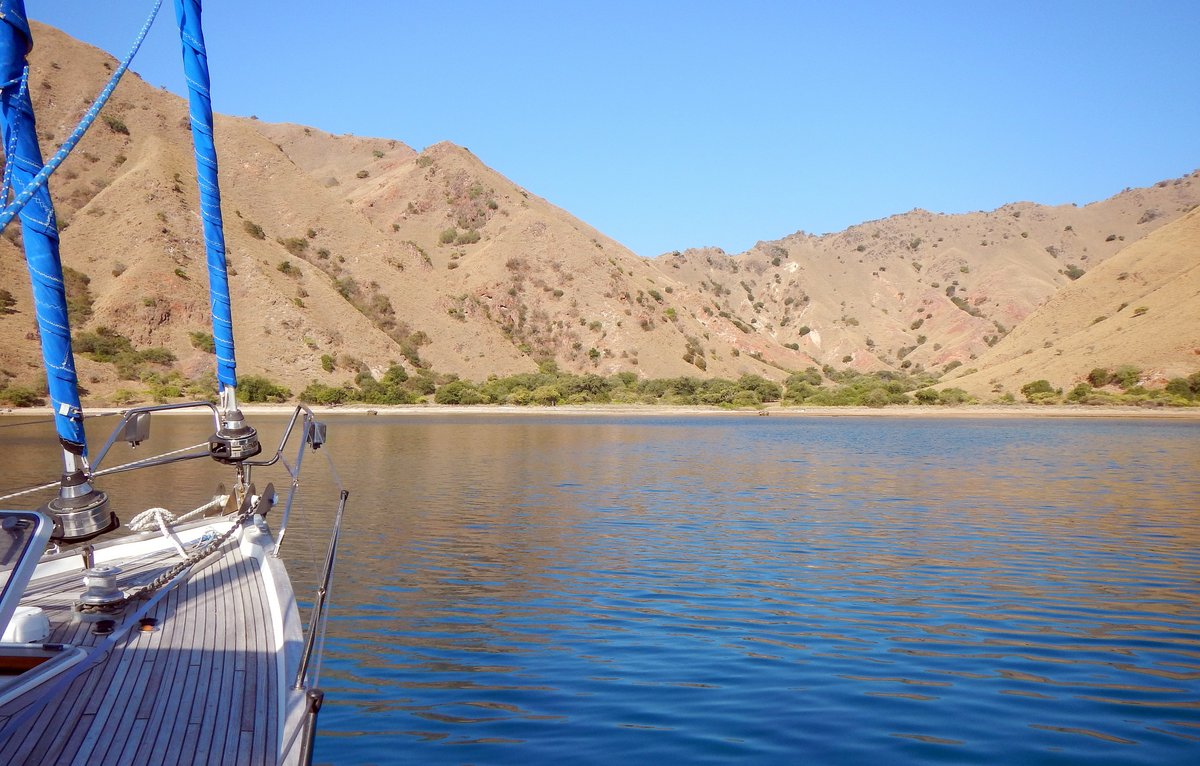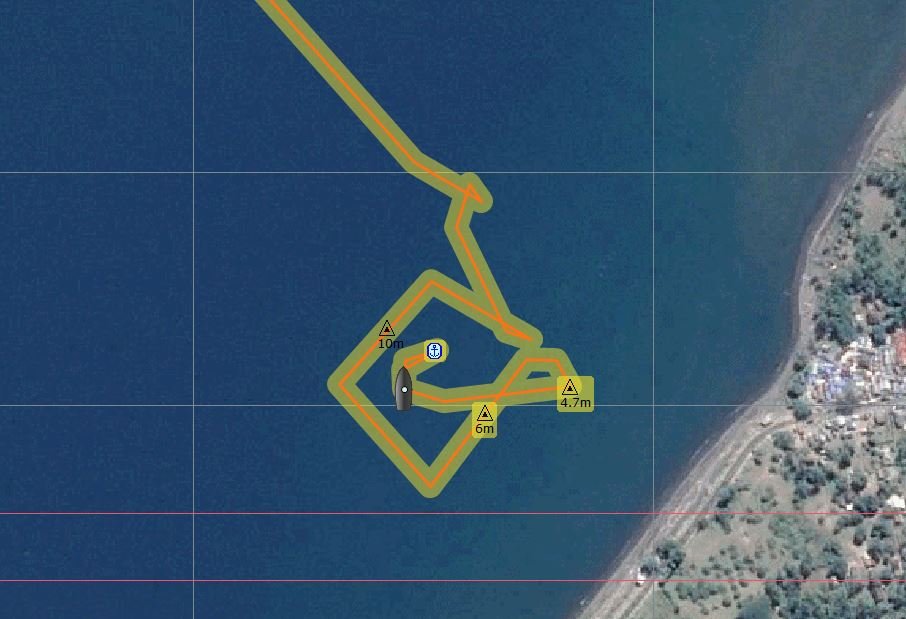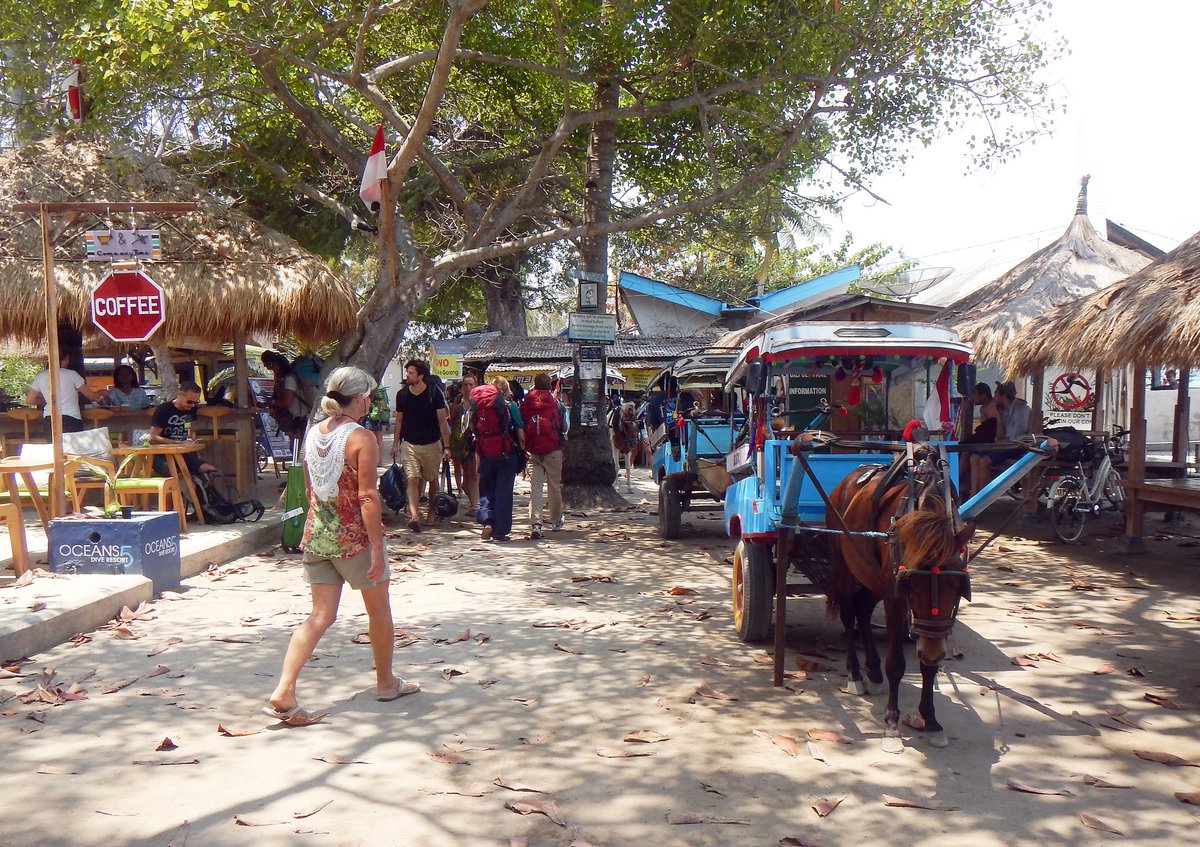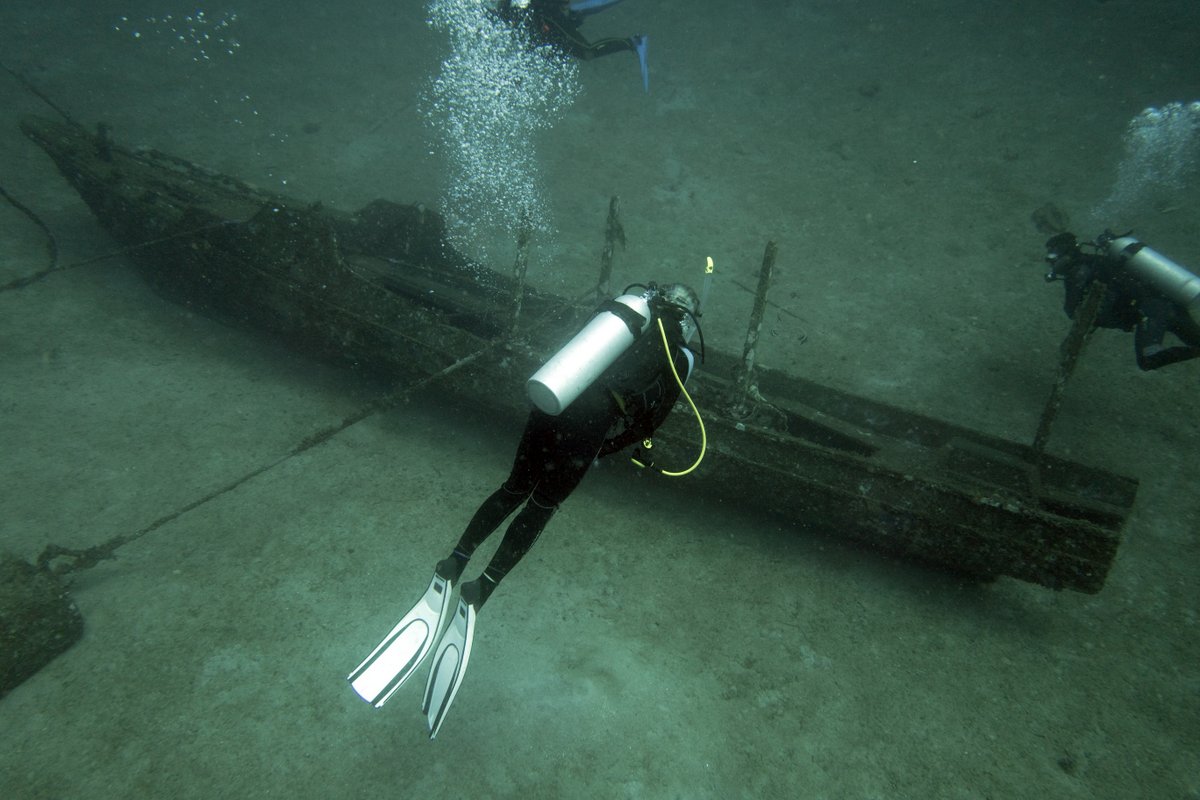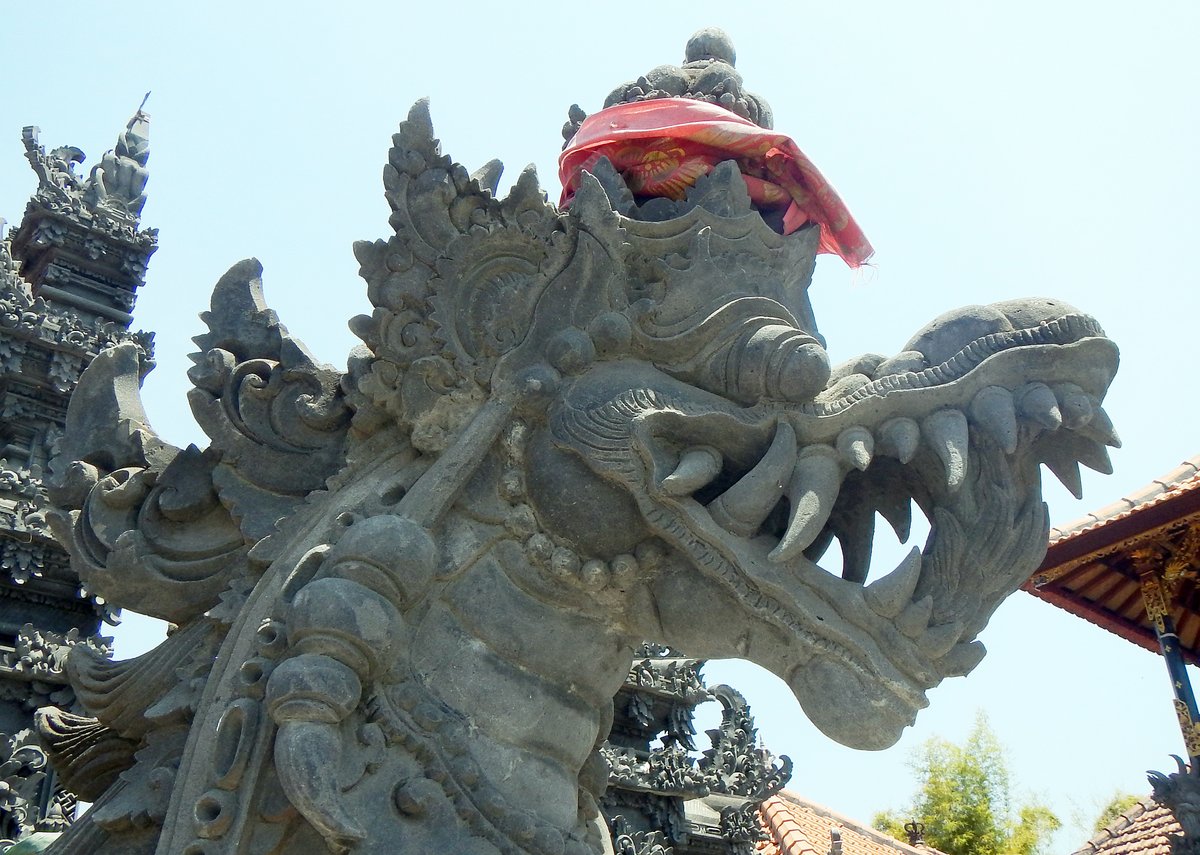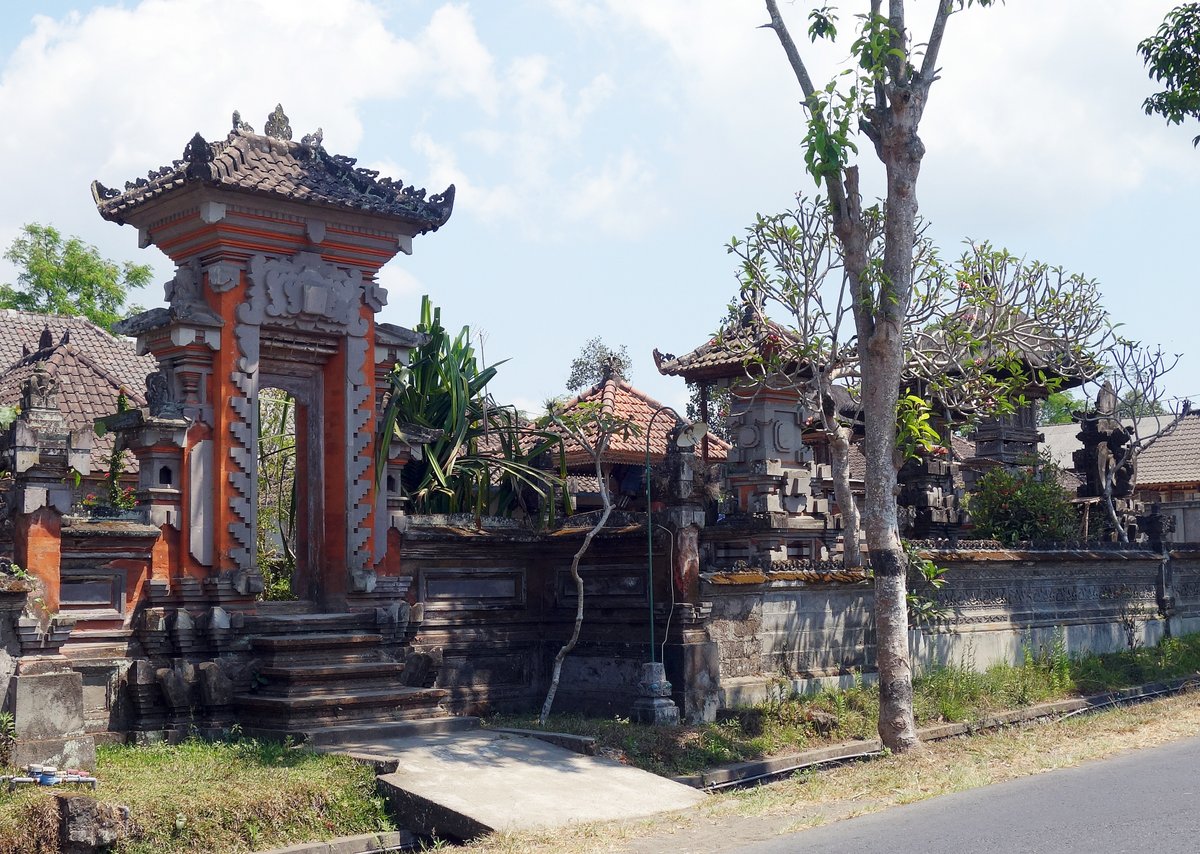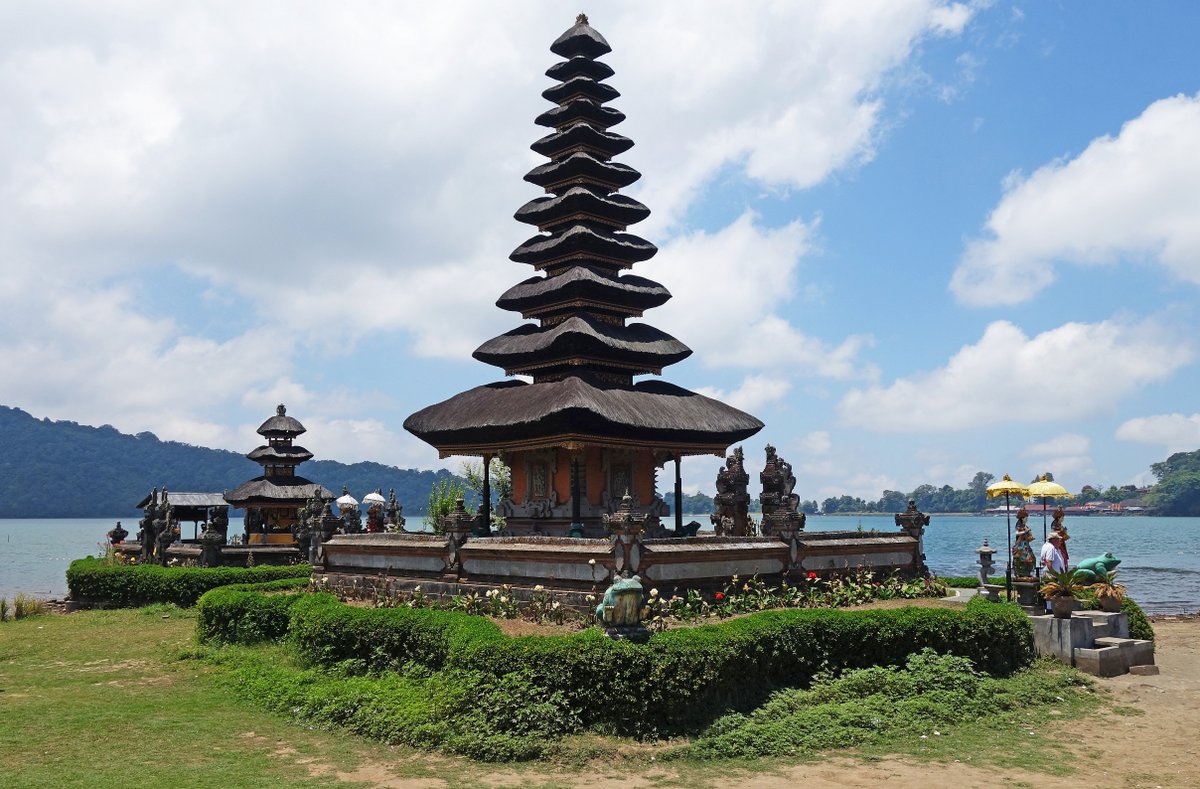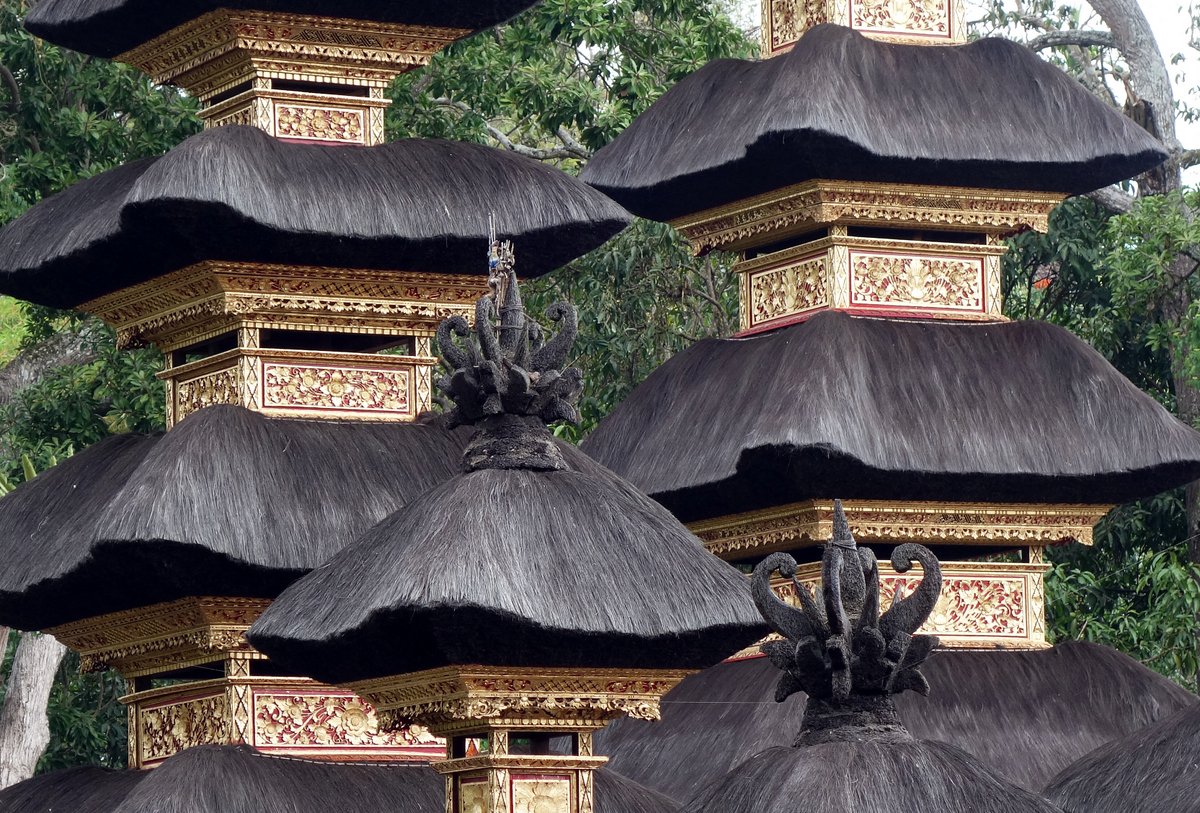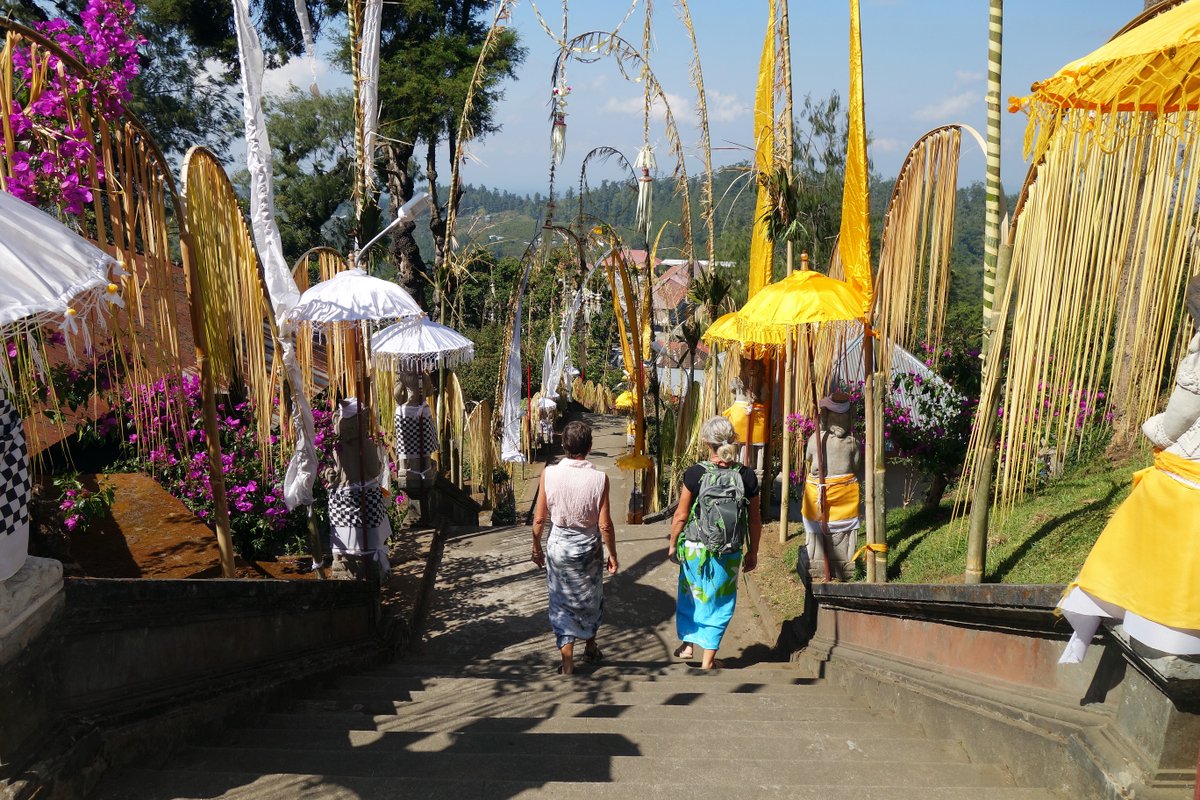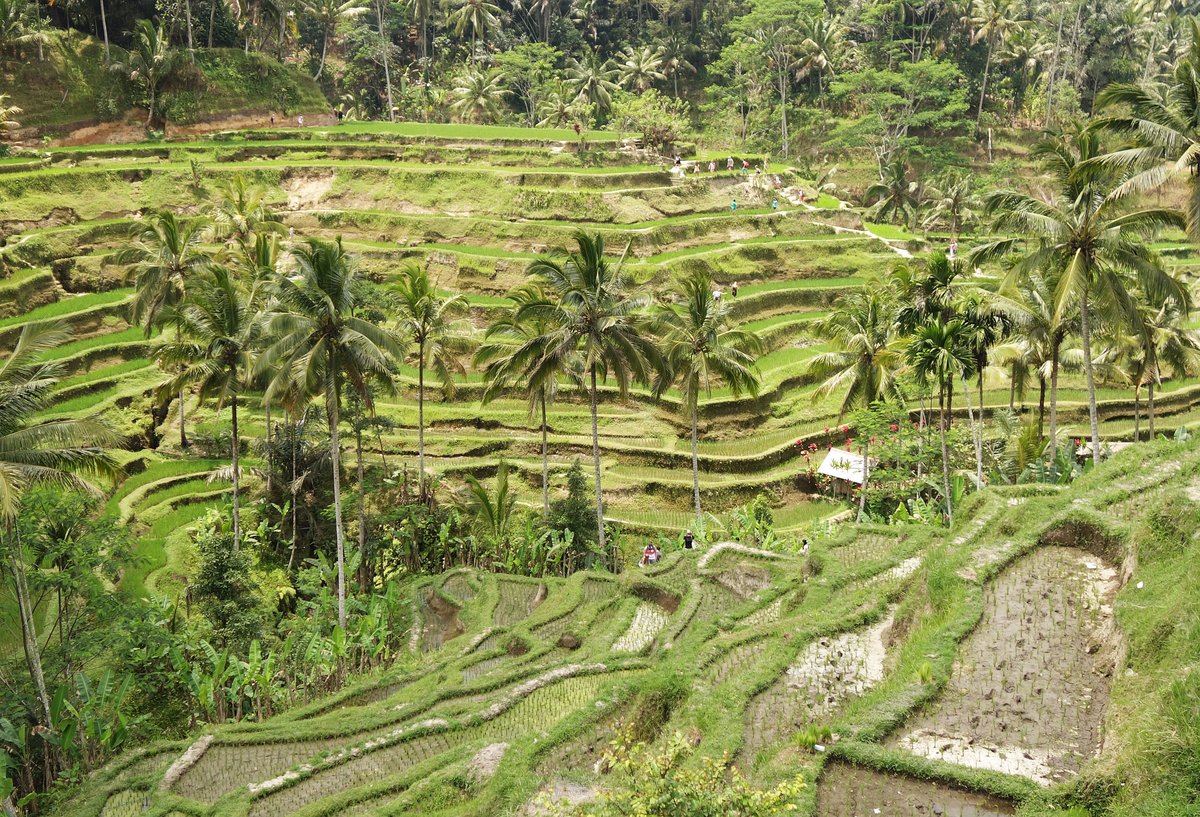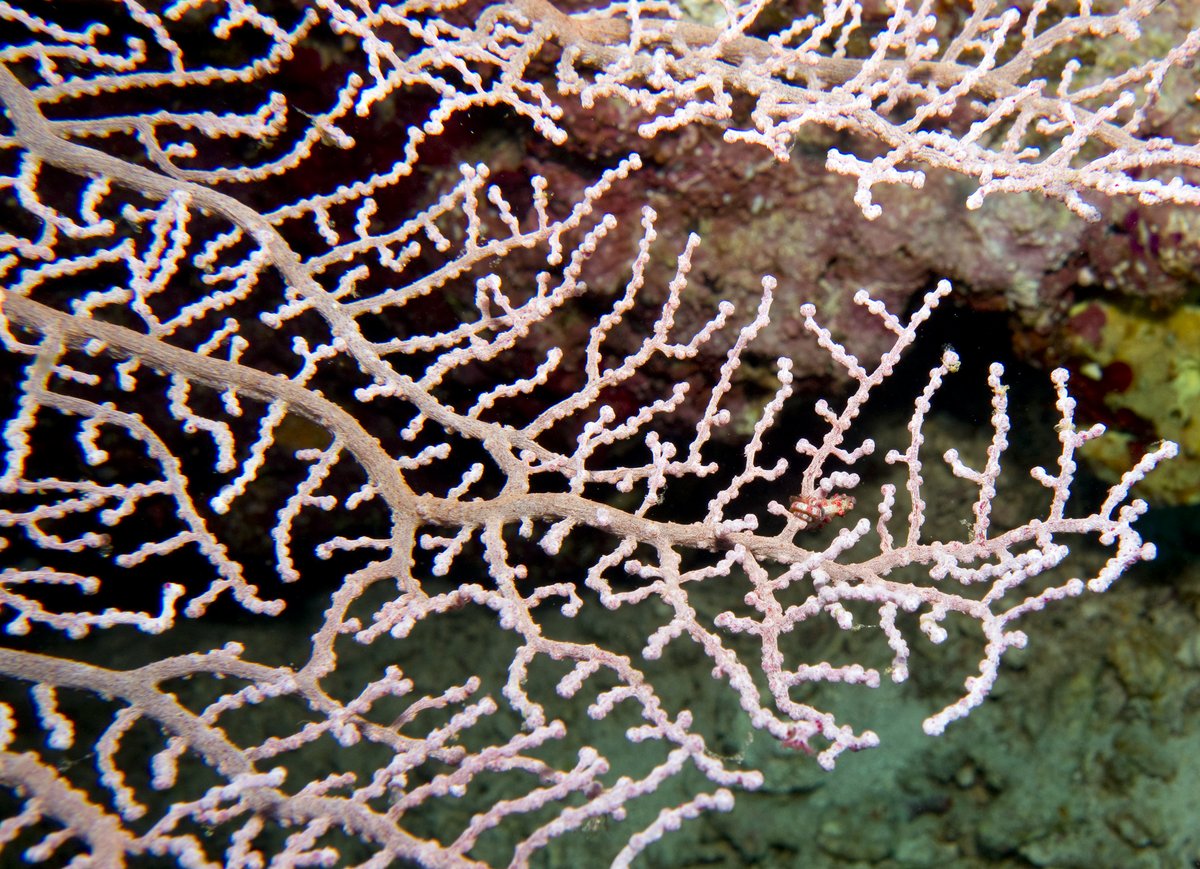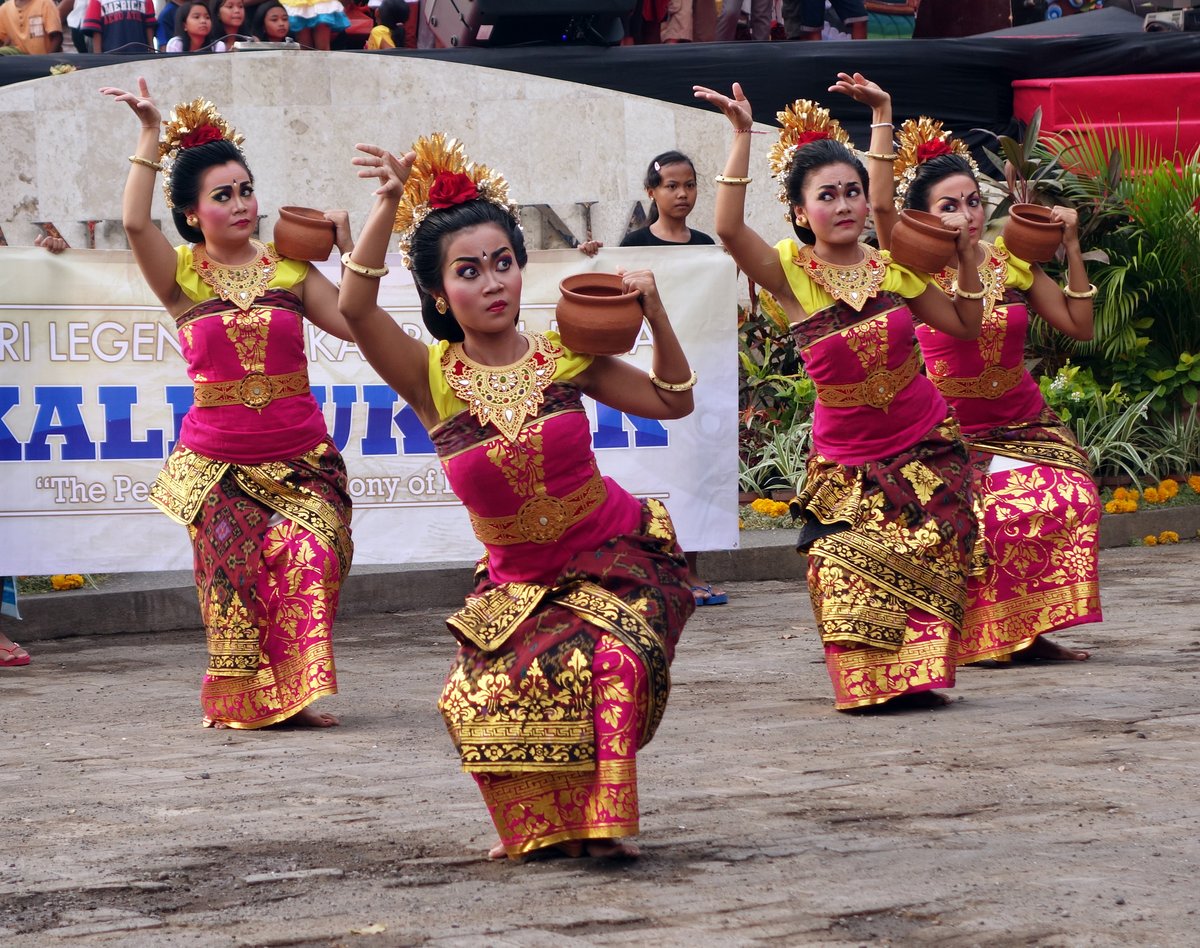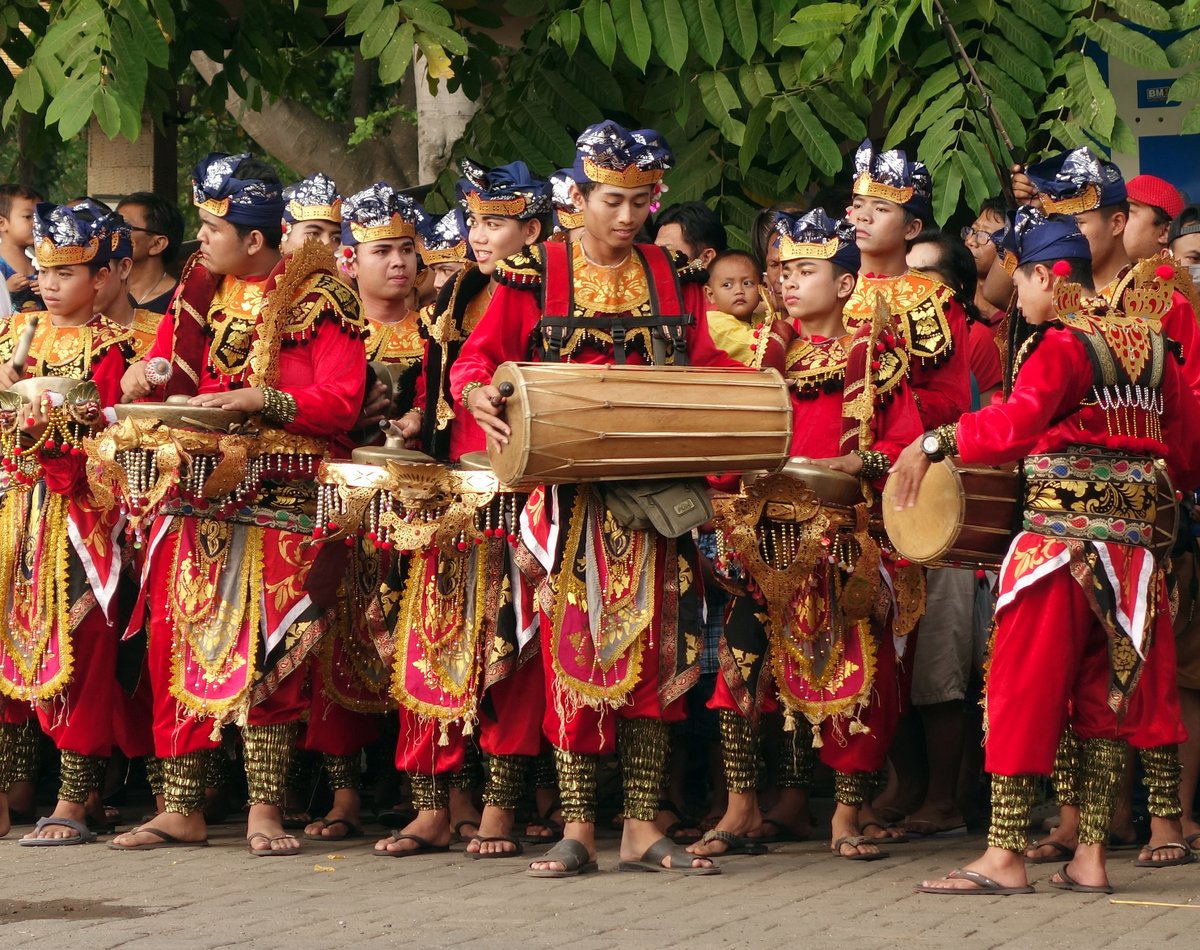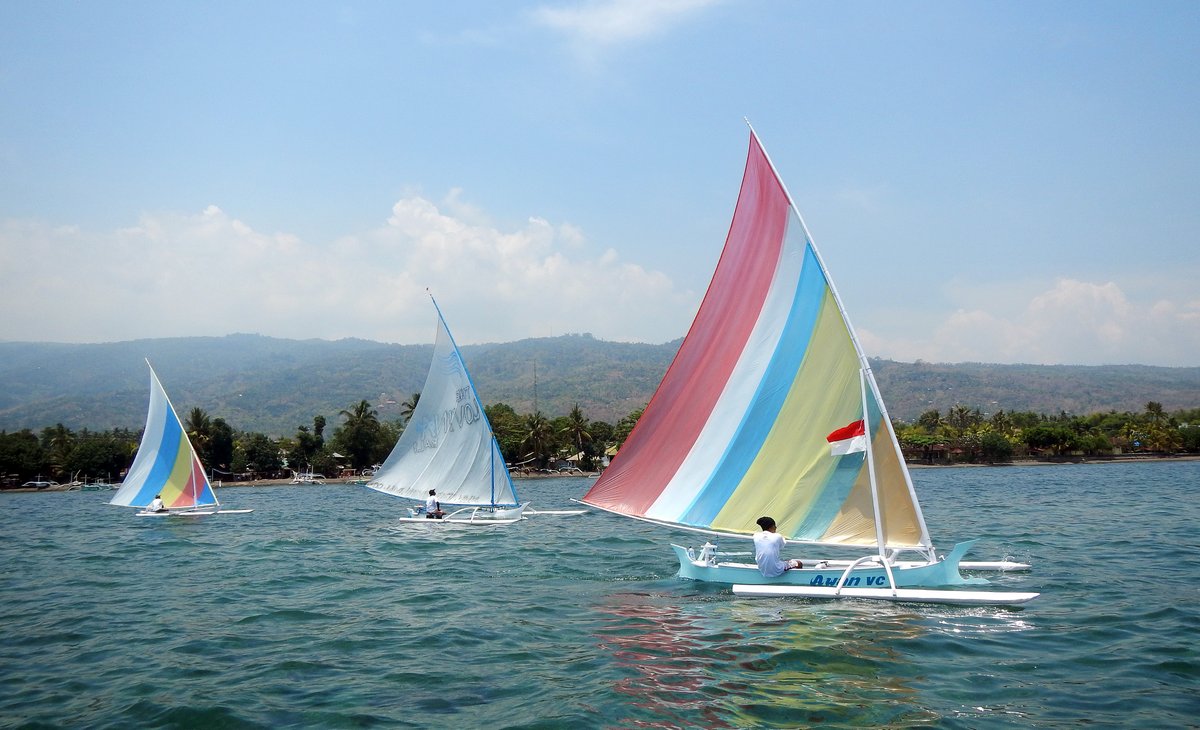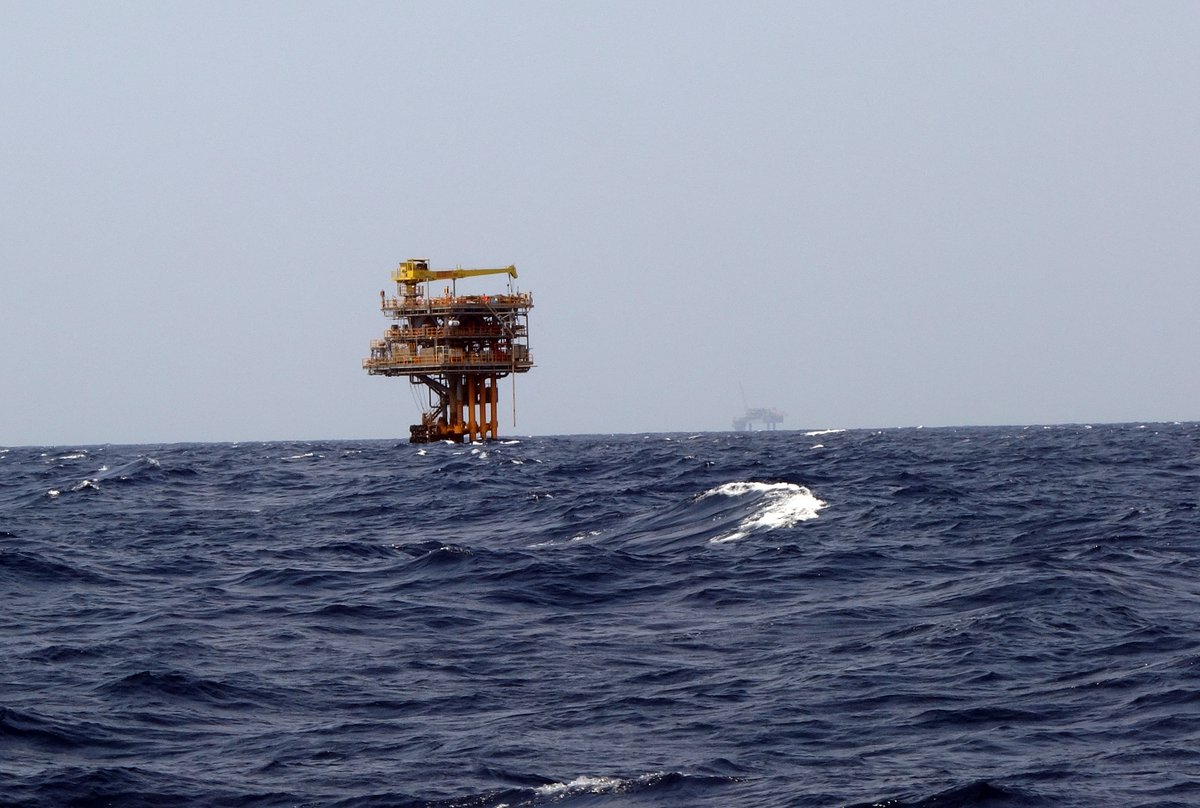1 September 2015 Telaga Island to Sikeli, Bombana
After breakfast, we started to pull up the anchor and found dozens of six inch long, white Sea Cucumbers clinging onto our chain. I didn't want the anchor locker stinking of dead creatures, so I had to cut each one off individually, which took quarter of an hour on 20 metres of chain. Strangely, no-one else had this problem.
Having escaped the anchorage, we motored for a couple of hours before the wind picked up giving us a cracking downwind sail for two hours.
We were a little apprehensive as we approached Sikeli Bay because there's a long fringing reef and scattered sand bars a couple of miles from the shore. The charts don't have much detail and we became even more nervous when we spotted a small island that wasn't marked on the charts at all. To make matters worse, the wind had picked up to over 25 knots; we had 1 metre waves and the skies were overcast.
We rolled away the main sail and reefed the genoa to slow down, then gybed to take us through a gap between two shallow spots in the reef. Our waypoint was 5°18.951S 121°47.197E. The Navionics charts turned out to be fairly accurate and the minimum depth that we saw was seven metres before it increased to 15 metres inside the reef. The depth then gradually decreased as we sailed towards the small town of Sikeli where we anchored at 05°15.55S 121°47.79E in 6 metres of water about 100 metres from shore.
The island of Kabaena is 100% Muslim, which is very apparent from the tall minarets of the four mosques that we can see from the anchorage. Only six boats have come to this port, the other five have started to head south - we all stayed on board chilling out.
We've been in a strongly Muslim part of Indonesia for over a month now and I'm becoming a bit of a connoisseur of the Adhan (Call to Prayer), which is broadcast by every mosque five times a day.
The first one is at twilight (0430) and the last is after sunset (1900). The words for the Adhan are the same every time that it is sung (apart from an additional phrase before dawn, which states "Prayer is better than sleep" to get the lazier believers out of bed.)
These are the words to the Sunni Muslim Adhan (the words for Shia and other branches of Islam vary slightly):
Allah is Most Great. (four times)
I bear witness that there is no God but Allah. (twice)
I bear witness that Muhammad is the Messenger of Allah. (twice)
Hasten to prayer. Hasten to prayer. (twice)
Hasten to Success. Hasten to Success. (twice)
Prayer is better than sleep (twice, but only in the morning.)
Allah is Most Great. (twice)
There is no God but Allah.
The Adhan is sung by the Muezzin, who is one of the most important men in a mosque - women are not allowed to sing the Adhan because their voices are too provocative. At first I thought that the Adhan was a recording, but every performance is live and that is one of the problems. The quality of the singing is very variable, some sound beautiful, melodic and poetic, while others do not. Unfortunately, the beautiful singers are few and far between.
All mosques have loudspeakers which boom out the Call to Prayer, but most sound systems seem to be distorted with the Muezzin screaming into the microphone or the amplifier turned up so loud that the Rolling Stones would be happy. There are often multiple mosques in each town, blasting out their message at slightly different, but overlapping times, which distorts the message even more.
The early morning Adhan (at about 0430) always seems to be louder than the rest. Our solution is to close the hatch above our bed and turn on our two electric fans, which make a neutral whirring noise and cancel out the sound.
2 September 2015 Sikeli, Bombana
The local rally team had told us to be ashore by eight o'clock and, after making us dress in Sail Indonesia t-shirts, we were loaded into cars and then driven up a very bumpy road for nearly an hour to a village called Tangkeno, which is high in the mountains.
After a short walk around the village, we were invited in to someone's house to use their toilet. The owner was kind enough to show us her home as we waited and it was lovely - simple unpainted wooden walls and floors and very cool with lots of windows.
We were then led up the hill to a big parade ground, with two Barugas (raised platform) at either end. In one of the Baruga’s, we found a group of local dignitaries dressed in their splendour, waiting for us. We were introduced to the King of Kabaena and the Regent of Bombana who had travelled here from the capital of Bombana to attend this event. There were a few short speeches and we were given platters of snacks including Cucur and Bamboo rice.
Some traditional dances were performed and we were invited to join in. We were treated to a lovely performance by a group of young school kids playing brightly coloured bamboo instruments, including flutes and primitive trombones. They were very good and the concentration on their little faces was a delight.
After a buffet lunch on a patio overlooking the impressive Mount Sambampululu, we were invited to sit on chairs in the other Baruga, where listened to a speech by the Regent and another by Giza from “Rotor”. The Regent then came around with a tray of Agate rings and offered one to each of us. We’ve seen these large ornate rings for sale in some of the markets and they are very popular, so it was a welcome surprise to be given one.
A couple of traditional dances were then performed. The first was a very dramatic dance with fifty or so girls and some kind of queen and the second was an interesting dance involving eight men and four ladies.
The men carried long poles which they held close to the floor and slapped together in rhythm to the drums. The girls then danced in and out of the poles trying not to be hit. They gave us cruisers an opportunity to join in and Eva and Karen had a go - harder than it looks.
With the formal dances over, we were invited to join in a huge line dance holding hands in a big circle. I’ve said this before, but the Indonesians LOVE line dancing and everyone including the dancers and local dignitaries joined in. The only trouble is that they just carry on and on and ON until people drop out. The same tune went on for over fifteen minutes, but everyone had a good time.
After the end of the formalities, we walked up to an old fort - about a kilometre in the beating afternoon sun. There wasn’t much to see, but we stretched our legs and worked off a little bit of the big lunch. Back at the parade ground the guides looked shell-shocked at all the exercise and we hung around for an hour, chilling out while they rested. I have a low threshold of boredom and by four o’clock I’d had enough sitting around and motivated everyone back into the cars and home.
In the evening, “Laragh” invited everyone for sundowners and a bit of a jam session.
3 September 2015 Sikeli, Bombana
We’d arranged to go for a hike to the top of Mount Sambampululu, which is an impressive rocky peak that can be seen from the anchorage. There were nine of us and one of the rally organisers (Akmed) asked us to pay 200,000 rupiah ($20US) each for the transport and the guides who would take us on the hike. None of the interpreter guides came along, having been traumatised by the short 1 kilometre walk yesterday.
We were driven to a village on the way to Tangkeno, where four teenage guys met us and acted as our guides. None of them spoke any English, so we relied on our poor Bhasa Indonesia and sign language. It was a great hike - at first along a dirt road, then soon on faint trails through the forest following a ridge. We arrived at the eastern side of the steep-sided rock cliffs after two hours of fairly hard slog. The huge cliffs towered above us while we had an early lunch.
Yesterday, I'd had a look at the mountain on Google Earth and there seemed to be a gully with trees on the south side of the mountain that might give access to the top of the rocky peak. So, I left the others chilling out and went to have a look around. The lead guide followed me and when I indicated in sign language that I wanted to have a look, he shot off like a mountain goat down a gully.
He led me westwards along the bottom the cliffs, which seemed to be impenetrable without serious climbing gear. After fifteen minutes of fast scrambling, we stopped at a cliff that had a tree growing up the side. The guide indicated that this was the way up. It looked tricky, but I'd come this far, so why not?
I would say that it's a V.Diff using the tree and the vertical rock face, with the crux at a point where you have to swing out around the overhanging tree trunk. Once at the top of the initial steep section, it’s a scramble up to a subsidiary peak. The mountain is actually made up of four peaks surrounding gullys. From the peak that we were on, I would say that the highest peak could be climbed in a couple of hours of scrambling. It would be an epic day out.
We scrambled back down and met the rest of the group coming to see where we’d gone. Graham from “Red Herring” is also a mountaineer and once he’d heard that I’d gone up higher, there was no stopping him. When Graham had come back down, we heading back along the face of the cliff and down to the village, which took a couple of hours.
We were invited into the guide’s parent’s house, where they kindly gave us some water and pamplemousse to eat. There was some confusion about a payment for the guides. There was no-one who spoke English and we had great trouble explaining that we’d give the money for the guides to the rally organisers in town. Eventually we got into the cars and went back to Sikeli to sort the money out, leaving the guides unpaid at the village - they looked unhappy, so it wasn’t a nice farewell.
Back in town, Akmed said that the guides will be paid, but we’re not too sure. If there’s a mix up with the money, then it’s normally the small guys who lose out -no doubt the taxi drivers will get paid first, so I hope that the hiking guides get paid. In future, we’ll make sure that we only pay after the trip.
Akmed then tried to get us to go on a trip tomorrow, out to the nearby Sagori Island, but it seemed very complicated and he seemed to be trying to get as much money as he could from us - $10US each for a one mile trip, $5 each for a meal at the school and then even more for the interpreter guide’s time. It was so confusing that we’re all paranoid that we’ll be sucked into chaos and the costs will escalate. The trip is only to go snorkelling, which we can do anytime, so we politely said no.
The last couple of days have been great, but of the places that we’ve stopped in this rally, the guides here seem to be the least organised. I think that they’ve been shipped in from other parts of Bombana, whereas in other places, we’ve been dealing with the locals. I suspect that the problems with Akmed all stem from the fact that he isn’t from Sikeli and the locals are trying to get him to pay expensive prices for things. The best and friendliest guides that we’ve had have been local students from high school or university, who have a genuine desire to chat in English.
We’ve decided to leave here tomorrow. Glenys and I have had enough of being organised on the rally, so we’re missing out the next two scheduled stops at Selayar and Lombok and are heading south to the isolated Takabonerate atoll to chill out for a few days.
4 September 2015 Sikeli to Takabonerate Atoll (Day 1)
Despite still being tired from yesterday's exertions, we were up early, getting ready to leave later in the day. My first job was to top up our fuel tanks from our three diesel jerry jugs before the wind picked up. After breakfast, we jumped in the dinghy and went over to the town to get some fuel.
It's complicated to get diesel and petrol in Indonesia. All fuel is subsidised by the government and foreigners are not normally allowed to buy it directly. It’s illegal for locals to buy fuel to resell and, in the more populated areas, policemen are posted at petrol stations to enforce the law. In most places, we will either have to pay an international rate of 15,000 rupiah/litre or get a local to buy some for us. If locals get it for us, they won't use our nice clean, containers, but will use a rag-tag of their own containers, so the police won't suspect them of reselling fuel to foreigners.
It was a lot easier in this small fishing town. There's a brand new fuel station right on the sea front, which only opened a couple of days ago. A local guy met us at the landing steps and helped carry the jerry cans to the petrol station. The forecourt was littered with various containers being filled for fishing boats, but they very kindly stopped filling them and immediately filled ours. We got 69 litres of diesel and 15 litres of petrol at the subsidised rate (< 8,000 rupiah/ litre), and were back on the boat within 30 minutes.
After stowing the jerry jugs, we went into town again to do some provisioning. Our first stop was to get the data SIM card in our iPad topped up. Again we had trouble with this normally simple job. In the first small shop, the guy spoke a couple of words of English and kept saying "Empty, empty". We tried to explain that we didn't want a new, empty SIM card, but he didn't understand. Eventually, we asked if there was somewhere else and he pointed us down the street.
The next shop was the same - the lady kept saying "Berakhir", which our dictionary told us was "Expired". Well, yes, our credit had expired, that was why we wanted a top-up. The lady then wrote down 4.1 GB data and told us to come back at two o’clock in the afternoon. The penny dropped. These small shops are only allocated a certain amount of air time each day and she had sold out. She would be topped up at two o'clock and could then top us up.
There was another small shop across the road selling SIM cards, so we tried there and to our relief, the lady had some data available, so we bought 3 GB for one month for $10. Five minutes later, we were on-line again. What a strange system.
We wandered around the market while Glenys bought some vegetables and some fresh prawns and I bought a small machete in a wooden sheath that is better weighted than my old one. White people are very, very rare here, so we caused chaos as everyone stopped what they were doing so that they could watch us. I guess that we paid slightly inflated prices for things, but it's cheap enough anyway. My nice new machete only cost 150,000 rupiah ($15US).
After lunch, Glenys cooked a meal for tonight at sea and I spliced an eight braid rope onto the end of our anchor chain. When we get to Takabonerate, most of the anchorages are deep and our 60 metres of chain won't be long enough, so I've added 40 metres of rope to it. It was a mission to splice it because the rope is old and the weave has tightened - it took me two strenuous hours, sitting in the beating sun.
We lifted the dinghy on deck and left at four o'clock into a strong 20-25 knot south wind. We bashed to windward until sunset, when, as we left the influence of the land, the wind started to decrease and back. The conditions got better and better as the night progressed and we had a lovely reach after midnight.
5 September 2015 Sikeli to Takabonerate Atoll (Day 2)
Together with "Red Herring", we arrived at the eastern pass into the atoll around eight o'clock and hove-to, waiting for the sun to get higher (also allowing Glenys to sneak in a couple of hours extra sleep).
The pass through the reef was very straight-forward and the shallowest depth we saw was around 9 metres. Our waypoints were 06°28.58S 121°17.80E & 06°28.51S 121°16.76E). “Ubatuba” was already anchored in 8 metres over sand at 06 28.71S 121 16.92E, but it looked too open to the waves coming through the pass. Instead, we headed south and anchored at 06°30.39S 121°16.89E in 6 metres of water over white sand amongst widely spread coral heads.
The water colours here are stunning - it’s much, much better than being stuck in front of a town (and no mosque droning away.) We chilled out for the rest of the morning and got the dinghy in the water.
After lunch, we jumped in the dinghy and went to look at the huge sand bar to the east of the anchorage. We arrived at low tide and the sand was miles long. We could see some local fishermen walking around in the distance and started to walk towards them to see what they were doing, but after fifteen minutes, we were hot and still only half way, so we gave up. There’s almost nothing on the sand apart from a few crabs scuttling away. Glenys was hoping to find a few shells but the area is as bleak as the Sahara Desert.
We retreated to the boat and went snorkelling on a patch of reef to the north of the anchorage. It was okay, but large areas of coral have been reduced to rubble, probably by dynamiting and there aren’t many fish. It’s a little disappointing because this is a National Marine Reserve and we were expecting pristine reef. It looks like the locals are still allowed to fish here because at sunset, we could see a dozen or so fishing boats in the five miles around us.
6 September 2015 Takabonerate Atoll
We had a quiet morning, making water and catching up on small jobs. In the afternoon, we went for a snorkel, starting off in the shallower water to the east of the anchorage near the sand bar. It was okay and the water was fairly clear, but much of the coral is damaged either by storms or more likely destructive fishing practices and there weren’t many fish.
I swam back to the boat and the quality of the reef improved nearer to the anchorage. It’s mostly sand with good coral on the isolated outcrops, but the water clarity reduced. I found some False Clown Anenomefish, which amused me for a while.
We were invited over to have dinner on “Red Herring”, Karen made some Nasi Goreng and Glenys made an Indonesian chicken stew, which went together well. Karen and I had a good session on our guitars working through the songs that she plays.
7 September 2015 Takabonerate Atoll
Takabonerate is the third largest coral atoll in the world covering an area of 1,000 square miles, with around fifty distinct reef systems. We entered at the north-eastern corner and were keen to explore further. Unfortunately, we only had a few days to do so. We upped anchor at nine o’clock (as soon as the sun was high enough to give us decent light) and motored west through a pass in the seven mile diameter reef system encircling us.
There’s a park ranger station at an island called Tinabo (06°34.12S 121°05.62E), but the anchorage is in 30 metres on the edge of a steep drop off and we’ve been told by “Per Ardua” that the park rangers will try to charge us a park fee of $10US for the boat and $15US per person PER DAY, so we’re avoiding that island and exploring other areas.
The weather in this region of Indonesia is perfect. For the past month, we’ve had blue skies and consistent 15-20 knot winds from the south-east to east. Today was no different and to make it even better, we were sailing in flat calm water in the lee of the reefs surrounding us.
From another cruiser’s blog, we’d made a note of a possible anchorage at 06°39.28S 121°12.03E and we had a lovely sail to get there. Unfortunately, when we arrived, there was only one small spot that was shallow enough to anchor in and that was littered with coral heads. We thought that it wasn’t even good enough for a lunch stop, so we headed west for another anchorage.
An hour later, we anchored at 06°43.25S 121°08.76E in 6 metres of water over white sand amongst scattered coral heads. To get to the anchorage, we had to weave our way through coral heads that appeared to be several metres underwater, but in good light it was simple enough. This is another beautiful spot with a large sand bar at low tide. “Red Herring” followed us in and anchored behind us.
Glenys and I jumped into the dinghy and went off to explore a shallow reef that we’d spotted on the way in, but the reef was again mostly rubble. This should be pristine reef and it’s very depressing to see it in this state - perhaps the marine park status will help it recover, but later, as night fell, we could see twenty fishing boats within view, so I don’t hold up much hope.
Karen and Graham went for a walk on the sand bar at low tide and came back with some nice shells, so there’s good shelling here. Unfortunately, by the time they stopped by, the tide was coming in fast, so Glenys missed out, but at least Karen gave her a lovely, big Cassis shell.
I’m very frustrated here, the anchorages and water colours are stunning, but the snorkelling close to the anchorages is very poor. There are plenty of very steep drop-offs going down to 40-60 metres, which I suspect would be good scuba diving, but there’s nowhere to anchor close by. From the protected anchorages, we would have to travel a few miles in our dinghy to go diving and we don’t want to do it alone - “Red Herring” don’t dive and they don’t have a big outboard on their dinghy, so we’re very restricted here in the middle of nowhere. In retrospect, we should have travelled in company with other keen divers.
8 September 2015 Takabonerate to Labuan Bajo, Flores (Day 1)
After a leisurely breakfast (waiting for the sun again), we left the anchorage and weaved our way through the maze of sand bars and reefs, heading south. Once again, I was very grateful for the KAP charts that I’d previously made from Google Earth because they were spot on and showed every channel, whereas the commercial Navionics charts gave us very little detail. At one point, the Navionics charts showed a reef blocking our way whereas in reality we had a 100 metre wide, 20 metre deep channel.
Just before lunch, we caught and landed a nice 10lb tuna as we approached Tambuna Lompo Island (07°00.27S 121°12.9679E). Our plan was to stop overnight at this idyllic-looking, deserted island, but we couldn't find anywhere to anchor. Very shallow coral stretches 350 metres from the shore and then plunges down to 40 metres. We tried to anchor in 10 metres depth about 15 metres from the reef edge in a sandy valley, but the anchor just dragged - probably rubble. After fifteen minutes, we gave up and set off on 130 mile passage down to Labua Bajo. It was very frustrating because it looked like there would be good diving around the island.
There wasn't much wind (and what we had was behind us), so we motor-sailed all afternoon, until we rounded the western end of Pulua Kaloa when we finally had enough wind to sail. We had a lovely overnight sail doing 4-6 knots over the ground.
En-route, we did some planning - we need to be in Bali by the 22nd September to meet up with the rally again, so we've only got ten days to get there. This is a tad frustrating because Bali is 300 miles away and we’ll spend 3 or 4 days sailing, leaving us with only 6 days to do some diving and exploring.
After much agonising, we've decided to stay in Komodo for a week, then sail to Kili Air island on the west coast of Lombok, where we should be able to spend two or three days chilling out before sailing overnight to Bali. It’s all a rush, so we’ve just got to cherry pick the best places.
9 September 2015 Takabonerate to Labuan Bajo, Flores (Day 2)
Dawn found us thirty miles from Labuan Bajo and we managed to carry on sailing until just before nine o’clock, when the wind died as we approached land. We arrived at the anchorage off the ECO Lodge (08°31.13S 119°52.04E) at noon.
We had a quick lunch on board, then dinghied 1½ miles into town. Labuan Bajo is a very busy tourist town with all the dock space taken up with local fishing boats, tourist boats and cargo ships. We eventually found a place at the floating dock just outside the fish market. There were lots of local boats coming and going, so we locked the dinghy up and prayed that everything would still be there when we got back.
The market is a horrible, stinking place. The main product on sale seems to be dried fish, which stinks to high heaven. Added to this, there are open drains running through the place, loaded with festering rubbish. Vegetable vendors sit on the ground next to the drains, selling their wares, which look surprisingly colourful and fresh. It’s an overload of colours and (mostly bad) smells.
The main street is a dusty, rutted road that follows the contours of the shore, lined with small stores and tourist shops. Rubbish is strewn everywhere and the place has a run-down, scruffy appearance.
Our plan is to go diving tomorrow with a commercial operator, so we called in a few dive shops. There are dozens of dive centres advertising diving trips, so it was difficult to know where to go.
We tried a posh shop called Blue Marlin, but they wanted $150 US to do a three-dive trip. We tried some of the local operators, who were a lot cheaper, but didn’t have a plan for the next day and seemed very chaotic. We then chatted to an Austrian guy in Diver’s Paradise Komodo, who had a planned itinerary for tomorrow, was only $90US for three dives (including $15US daily park fee) and seemed very professional, so we handed over our money.
After buying a few provisions, we wandered back to the market, where Glenys bought some vegetables. Thankfully our dinghy was still there and undamaged. We zipped back to the boat and reappraised the anchorage at Eco Lodge. It’s an open roadstead, with a long shallow sandbar/reef protecting the beach. We were hoping to be able to have dinner at the Eco Lodge, but the logistics of getting over the sand bar in the dark didn’t seem to be worth the effort.
We upped anchor and moved closer to Labuan Bajo town, anchoring in 20 metres at 08°30.13S 119°52.51E. The anchorage is in the middle of a fleet of large tourist boats that look like Greek gulets. These wooden boats are used to take guests out on luxury, multi-day cruises around the Komodo, we’re told that some of the more luxurious 80 foot boats only take 2 guests and cost over $5,000USD per day.
10 September 2015 Labuan Bajo, Flores
The alarm went off early, so that we could go diving. We jumped in the dinghy just before seven o’clock and zipped to the dock where the diving boats are berthed. I left Glenys in the dinghy and walked to the dive shop to pay and join the group. After they’d walked us to the dive boat, I zipped back to Alba and the dive boat came and picked me up. It was all a bit complicated, but I felt much happier not leaving our dinghy in town.
It was a brilliant day’s diving. The boat was very basic and a little bit slow (it took over two hours to get to the first dive site), but comfortable enough. They even had a resident Praying Mantis wandering around on the upper deck, which amused us for a while.
Our first two dives were in the world-famous Gili Lawa Laut area, which is on the northern tip of Komodo Island. We dived Crystal Rock and Shotgun in the morning - both drift dives. Crystal Rock is an isolated pinnacle with good pelagic fish and Shotgun is a drift dive in a channel between two islands. We dived in a group of five divers and the pace set by the dive master was a little too fast for my liking making taking photographs difficult. Having said that, the fish were extremely unafraid, so I took some good photographs of a very friendly Hawksbill Turtle and a Titan Triggerfish.
After a reasonable lunch of tuna and rice, we did a drift dive called Tatawa Besar. Sometimes whizzing along at five knots, this was a very fast drift dive - not good for photography as the subjects were whizzing past, but great fun. The coral was in fantastic condition and it was nice to just look at it passing by. We spent the last fifteen minutes of the dive in a sheltered spot out of the current, hunting small creatures such as the colourful Kubaryana's Nembrotha and a 4 cm diameter Upsidedown Jellyfish.
Great day out and world class diving - we found the staff of Diver’s Paradise Komodo to be very friendly and professional.
11 September 2015 Labuan Bajo, Flores
Yesterday’s dives were so good that we decided to hang around for a few more days and do some more diving, so we went into town to arrange another day out tomorrow.
Again we tried a few dive shops. Diver’s Paradise were going to the same area, so we eventually opted for Uber-Scuba, which is run by an English and German couple. They are a little more expensive at $105US for three dives (including the park fees), but it sounds like their boat is much more comfortable and they’re going to a different area. They couldn’t handle a credit card, so Glenys had to put her credit card through the ATM four times to get out 4,000,000 rupiah to pay for it all and give us some spare cash.
We did a bit of food shopping and went back to the boat. The anchorage was getting hot and stuffy, so we motored out to the nearby island of Tebolon, so that we could run the water maker in clean water and go snorkelling. We anchored at 08°28.79S 119°50.11E in 15 metres of water. It seemed to be sand, but the wind was blowing us onto the shore - okay for a day stop, but it would be uncomfortable overnight.
I ran the water maker, but it stopped all by itself after one hour and I couldn’t get it to run again. The high pressure pump just wouldn’t start and made a horrible humming sound. I did a little bit of investigation and narrowed it down to one of three faults - the generator is not producing enough power; the electric motor is damaged; or the high pressure pump is damaged. None of these are good news. I gave up and decided to let it cool down while we went snorkelling.
The snorkelling was okay, mostly rocky reef with the odd bits of coral. Mid-afternoon, we motored back to the anchorage and I had another go at the water-maker. I kept trying to start it, ignoring the horrible humming noise and after five or six attempts, there was a big bang and the motor started.
This was worrying to say the least… I ran the pump for a minute then increased the working pressure of the pump. All seemed to be okay apart from a foul acidic smell coming from the electric motor. I traced this to a large capacitor, which was venting smoke through a big crack in its plastic case.
My conclusions are that the starter capacitor is damaged and needs replacing - this has happened before and I’m annoyed that I don’t have a spare one. However, it’s good news that the pump is not damaged and the generator works. Hopefully I’ll be able to find a start capacitor here in town - it should be a common enough item.
12 September 2015 Labuan Bajo, Flores
It was another early start to go diving. This time we’d arranged for Uber-scuba to come directly to Alba to pick us up, which worked well. Their boat was a bit more comfortable than the previous day and the food was excellent, being cooked on board.
They took us to the central region of Komodo National Park. Our first dive was at Siabar Besar, which was fabulous. We dived as a pair with our own dive guide, so we could go as slow as we wanted. The guide was great at spotting unusual creatures and found us a Giant Frogfish, an Ornate Ghost Pipefish, a pregnant Thorny Seahorse and, best of all, a Flambouyant Cuttlefish, which hardly ever swim, but instead walk along the seabed using their tentacles. It was interesting that 50% of the dive was on a flat sandy area and that was where we found the unusual creatures.
Our second dive was at Manta Point, which is (obviously) a favourite place to spot Mantas. Most of the dive site is a very bleak, lunar landscape of coral rubble and sand patches. We saw a couple of Manta, but they kept their distance and the visibility was poor. The last part of the dive was on lovely coral where we hunted out more small creatures including the colourful Magnificent Chromodoris.
The third dive was at Tatawa Besar, which we had already done, but that was okay because it’s a fun dive whizzing along. I snapped a nice picture of a Yellowmask Angelfish at the end of the dive once we were out of the current.
The dive boat dropped us off at Alba and we had an early night, after another great day of diving.
13 September 2015 Labuan Bajo to Loh Buaya, Rinca
Michael from Uber-scuba had suggested that I might find a starting capacitor at a shop next door to them, but the guy didn’t have one and couldn’t suggest anywhere in town. This was not good news, as we only had enough water left for five days - we may have to get to Medana Bay Marina early to get water and try to find a capacitor.
We upped anchor and motored through the reefs to Rinca Island, with the intention of doing a hike tomorrow to search out Komodo Dragons. Loh Buaya is a long and narrow bay, with mangroves and very shallow water at the end. There are lots of local boats moving in and out of the anchorage, delivering tourists to the Park Ranger station ashore. We anchored close to the end of the bay in 12 metres of water, but as the wind swirled around we ended up too close to a French catamaran.
I went up to the bow and started to pull up the anchor, but when I took my foot off the “Up” switch, the windlass kept pulling up the chain. I stomped on the foot-switch a few times, but it wouldn’t switch off, so I had to run down below to turn off the trip switch to isolate the windlass. Despite fiddling for a minute or two, I couldn’t sort out the fault, so we pulled up the anchor with Glenys operating the trip switch below and me shouting instructions when to turn it off.
We anchored again using the manual clutch on the windlass, which didn’t run smoothly, so we didn’t anchor where we planned and finished up too close to the shallows at the end of the bay. We started to pull up the anchor again (with Glenys down below), but halfway through, a local boat was having problems near us having gone aground, so we had to wait for ten minutes with Glenys motoring around to keep clear of the other boat. Finally, we were able to lift the anchor and re-anchor in a reasonable place - very stressful.
At first I thought that the switch had jammed, but traced the problem to the relay controller. I removed the control box and stripped it down to find that one of the relay contacts had welded itself shut together. I managed to pull it apart and then cleaned up all of the contacts and got the windlass working again within an hour. Phew!
While I was on a roll, I had another look at the water maker. On the way here, I had a brainwave and checked the starting capacitor on the electric motor on our dive compressor - it was the same, 50uF!! I removed the capacitor and fitted it to the water maker. Success, it all started up, but I didn’t run it for long because the water in this bay is very silty - I’ll run it tomorrow when get we get to a cleaner anchorage.
While I was doing the repairs, Glenys went ashore and arranged for us to go on a hike to search for Komodo Dragons tomorrow at 0700 - no rest for me. While she was ashore she spotted a KomodoDragon, so I think that there are plenty about.
By five o’clock, the tourist boats had left and it was a lovely peaceful anchorage with only two other yachts anchored nearby. We’re surrounded by mangroves, with fish eagles hunting and Long-tailed Macaques monkeys foraging on the shoreline. It was all very nice, but to my mind Mangroves + Monkeys = Mosquitos, so we went to MOSCON 5 and put up the mosquito net in the cockpit.
14 September 2015 Loh Buaya to Loh Serau, Komodo
It was another early start. We were ashore at the ranger station at 0700 because we’ve been told that the Komodo Dragons are more active in the mornings. We did the two hour hike with other cruisers from “Dream Catcher” and “Flour Girl”.
The Komodo Dragon is the largest living species of lizard, growing to a maximum length of 3 metres and weighing up to 70 kilograms. As a result of their size, these lizards dominate the island, hunting and ambushing prey including invertebrates, birds, and mammals.
It has been claimed that they have a poisonous bite, this is not true - instead they have two glands that secrete an enzyme which helps to kill larger prey. The diet of big Komodo dragons mainly consists of Deer and Water Buffalo, though they also eat considerable amounts of carrion. The dragons’ legs allow them to sprint short distances, lifting their tails as they run.
Komodos often rise up on their hind legs just before attacking and the tail can deliver well-aimed blows that will knock down a weaker adversary. Their best weapons are their sharp teeth and dagger-sharp claws, which can inflict severe wounds. Komodo dragons also occasionally attack humans, so all the guides carry long forked poles to keep them away.
Mating begins between May and August, and the eggs are laid in September. About 20 eggs are deposited in abandoned megapode nests or in a self-dug nesting hole. The eggs are incubated for seven to eight months, hatching in April, when insects are most plentiful. Young Komodo dragons are vulnerable and therefore dwell in trees, safe from predators and cannibalistic adults. They take 8 to 9 years to mature, and are estimated to live up to 30 years.
We spotted several Komodo Dragons close to the buildings of the Park Ranger station. They’re attracted by the smell of food from the kitchen and the rangers still hand out the occasional scraps to them which act as nice little snacks for the huge lizards, so I guess that it’s worth their while hanging about.
The hike was very interesting; we spotted a few Komodo Dragons and also a water buffalo, some deer, wild pigs, megapode (a bird) and Long-tailed Macaque monkeys - all of which make a good meal for a hungry dragon. The water buffalo and deer were brought to the island by people from Flores, but they are now wild.
Near the end of the hike, we were shown a large female dragon who was guarding her nest. As we kept our distance from the very suspicious reptile, a young male dragon came wandering along the path. One guide used his forked pole to keep the male off the path and away from our group, which the dragon wasn't happy about. The female suddenly ran towards us to chase off the male and chaos ensued with cruisers backing away rapidly, while the two guides fended off the male (who was trying to run away through the middle of us) and the female (who was trying to chase him off). Very exciting stuff and showed us how fast these apparently docile creatures can move.
By the time that we arrived back at Alba, the tourist boats had descended on the bay, so we upped anchor and motored north to Loh Serau on Komodo Island, where we found a big patch of sand in 8 to 10 metres of water (08°26.75S 119°27.11E). It’s a lovely peaceful anchorage, the water is crystal clear and there’s no one else around.
We've been told that we’re not allowed to anchor in water less than 35 metres anywhere in Komodo National Park. This is a bit awkward and annoying especially because there are no moorings provided for visiting yachts. Apparently, every time that someone puts down a mooring, the local fishermen cut it away and steal the rope. I felt a little uneasy about anchoring here, but it’s at the far edges of the Marine Park and it’s doubtful that there will be any patrols out here.
15 September 2015 Loh Serau, Komodo
We chilled out in the morning, Glenys pottering about while I set about sorting out and editing the hundreds of photographs that I've taken over the past four days.
After lunch, I went for a dive by myself on the sandy area under the boat to practise some of my camera technique. I’ve not been happy with some of the photos over the past few weeks, so this was an opportunity to take pictures of boring subjects, trying out different settings. Hopefully, I’ll be producing better photographs in the future.
I still had some air left in the scuba tank, so I spent 30 minutes cleaning some of the hull. The propeller was a mess being covered with a 2-3 mm layer of hard growth and the hull is starting to grow barnacles especially Gooseneck Barnacles. I finished the propeller, but had only just started on the barnacles, when I heard a loud knocking on the hull.
When I surfaced, there was a park ranger boat tied to our stern with two of the rangers on board giving Glenys a hard time. We weren't expecting to see anyone at this most northern bay in the Marine Park, so it was a shock to see them. Despite my paranoia, they didn't seem to be at all worried about where we had anchored, but wanted to see the receipts for our park fees.
I dragged out the receipts that we’d received in Rinca yesterday and they decided that we’d already paid for yesterday, but we were ordered to go to the nearest ranger station to pay for today. This is 15-20 miles away and we didn't want to waste time doing this tomorrow, so the rangers agreed to accept the money directly from us. They wanted 150,000 rupiah per person per day -that’s $10US each - very expensive considering that they don’t have any moorings about.
If they’d been “old-school” officials, I would have suspected them of wanting to pocket the money, but they seemed to be earnest young men, so I made them write out a receipt and then took a picture of them in case there was any problem tomorrow with other rangers.
16 September 2015 Loh Serau to Amoramor, Lombok (Day 1)
We lifted the anchor before seven o’clock and motored north-west in a flat calm sea heading for the small island of Gili Air on the west side of Lombok. The wind soon picked up to 5-10 knots, but we carried on motor-sailing for an hour until the wind increased to 10-15 knots because there are very strong currents in the area.
The wind died as we passed to the north of Pulau Banta, but once clear of the island, we had a good sail for the rest of the day. Glenys caught a small tuna while I was having my afternoon nap. After dark, we stayed 5-6 miles off shore and followed the curve of the land, having to gybe the sails a few times as the wind changed along the coast.
The wind died completely just after midnight then slowly came back from the west - directly on the nose. By half past one, it had backed and increased enough to sail again - it’s hard work sailing along a coast. For most of the night we had a favourable one knot current.
This evening, we passed longitude 118°41.1E, which means that we’re exactly on the other side of the world to Prickly Bay in Grenada where we started our circumnavigation - we've travelled half-way around the world! We left Grenada on the 11th January 2012 and have sailed 22,513 nautical miles in the 3½ years that we've been wandering.
17 September 2015 Loh Serau to Amoramor, Lombok (Day 2)
In the morning, we had good wind and were doing over 7 knots over the ground. With 80 miles to go and 12 hours to sunset, it was touch and go whether we’d be able to get to the island of Gili Air before dark. The north coast of Lombok doesn't have any good anchorages and our research hadn't found any on the west coast either, so it was either get to Gili Air or heave-to for the night.
Unfortunately, the wind started to die later in the morning and by lunchtime we were resigned to spending the night hove-to.
Just after lunch, “Red Herring” appeared on our AIS and I chatted to them on the VHF. They spent a couple of days at Palau Moyo and are now heading directly to Bali. I explained that we faced a night hove-to and Karen came back a little later saying that she had found an entry in “Catamini’s” blog from a couple of years ago and they had anchored at a place called Amoramor on the west coast of Lombok.
I checked it out on the chart and it looked okay for a night stop. It was 30 miles away, so we could just make it before dark if we averaged six knots. We turned the engine on and hoped that we wouldn't meet a strong counter-current.
We arrived at the anchorage by half past five. Amoramor is a small fishing village with a black sand beach - more a road-stead than an anchorage. There wasn't any depth information on our charts and the sea bed is black sand making it impossible to judge water colours especially with the overcast sky that we had. We carefully motored in a rectangle, plotting out the depths between 6 and 10 metres, then anchored in the middle at 08°14.076S 116°17.705E.
It seems to be good holding, but there isn't much protection from the swell and we’re bobbing about a bit. However, it’s better than being at sea and we just had time to get a cold beer and watch the fishermen coming out to lay their nets before the sun went down.
18 September 2015 Amoramor to Gili Air, Lombok
It wasn't too bad a night, a bit rolly and we had waves slapping the stern as the current moved us around, but we slept well. There was absolutely no wind in the morning, so we motored all the way to Gili Air. It’s a tourist island and the shore line of the small one mile diameter island is packed full of restaurants and bars - as we motored around the island, we could see hundreds of people on the beach that fringes the whole island.
The small harbour was crammed with scores of local boats on moorings or pulled up on the beach and there were eight or so yachts at anchor or on moorings. We picked up a mooring, but a guy on a power boat told us that we’d get kicked off, so we went to anchor further out in 20 metres of water (08°22.00S 116°04.89E).
We went to chat to “Parlay” to get some local knowledge, then went ashore to grab lunch. There’s a narrow track which runs parallel to the beach, lined with small shops, dive centres, restaurants and small hotels. There are no cars or motor bikes allowed on the island, so the locals use small carts pulled by ponies to move heavy goods and act as taxis for tourists. It was quite a shock to our systems to see so many tourists, but it’s a relaxed place to chill out.
Having had our fill of Malaysian food over the last couple of months, we ignored the local Warungs and opted for burger & chips and a couple of cold beers at a touristy beach bar - luxury. We then wandered around for a while buying a few things at a small grocery store and we've booked a dive for tomorrow morning.
We spent the afternoon on-board Alba. There’s a constant stream of small ferries that power through the anchorage, bringing tourists from mainland Lombok or Bali. These don’t slow down as they enter the harbour and their bow waves can be up to a metre high, so we have everything stowed away like we’re at sea. Fortunately, they stopped in the late afternoon and we had a very peaceful night.
19 September 2015 Amoramor to Gili Air, Lombok
We went diving in the morning. The dive centre took us to a small bay on the Lombok mainland where we first looked at a couple of small wrecks and then swam across a huge sandy area to a shallow rubble area. It was a muck dive, so the whole point was to try to find small creatures, but the environment was a bit dull and all my photos came out muted - I need to reassess how I'm using my strobe. However, we saw some new creatures including a Dark Margin Glossodoris and a Tigertail Seahorse.
It was very, very hot in the afternoon with hardly any breeze, so we lounged about reading and dozing (and hanging on whenever a ferry went by).
20 September 2015 Gili Air to Lovina Beach, Bali (Day 1)
We spent the morning walking on the beach, doing a circumnavigation of the island - only about three miles. It’s a pleasant beach, but most of the coast line is packed with hotels and lodges and where there’s a gap, the locals are building. We had lunch in one of the beach side restaurants - Malaysian food this time.
On the way back to Alba, we spotted that “Laragh” had arrived, so we stopped by and chatted to David and Katrina catching up on their adventures over the past few weeks. They had a good time at Benteng on Selayar, but only three rally boats made it there.
They've been trapped at Medina Bay Marina waiting for their visas to be extended. It took three days to get their passports back and cost twice as much as we paid in Bau Bau. The whole process has been a nightmare with travel to the immigration office taking a whole day. Some people have spent over a week getting their visas sorted out, which is a horrible waste of time. Apparently Medina Marina is subject to swells and is very rolly, so having to wait there was very unpleasant.
We spent the remainder of the afternoon getting ready to sail to the north of Bali overnight. It’s an awkward distance of 75 miles taking 15 hours at an average of 5 knots and would be a push to try to do it in one day.
We upped anchor half an hour before sunset and motored for an hour until we cleared the western most Gili Island, when we were able to set a course of north-west and pull out our sails. There was a strong 20-25 knot winds from the south-west, so it was a boisterous sail. The wind slowly backed and we were going too fast, so we rolled away the main and the genoa and sailed on a broad reach with just the stay sail.
Just after our one o'clock watch change, the wind died completely and we motored the rest of the night.
21 September 2015 Gili Air to Lovina Beach, Bali (Day 2)
We picked up a sea breeze for an hour after dawn, but ended up motoring into the anchorage at Lovina Beach. We were met a few miles out at sea by a local boat called “Peter Pan”. He came to within 20 metres and then motored alongside us. He didn’t say anything, but seemed content to sit there and watch us for an hour all the way into the anchorage. He later came by and offered us his services to get water, fuel, laundry, etc. It seems that each yacht gets adopted by one of the local boats.
We anchored just after nine o’clock at 08°09.59S 115°01.30E. There are 16 rally yachts in the anchorage, who have all timed their arrival for a welcome party advertised for tomorrow. Unfortunately, it doesn’t look like it’s going to happen.
As in the other places that we’ve visited, the rally was timed to be here for a local event that was happening anyway. The Lovina Beach Festival is taking place, but it doesn’t start until the 27th. I don’t mind that there is nothing official going on here, but it would have been nice to have been told. We’ve rushed to get here in time for the events and have missed a few good anchorages, where we could have stopped and relaxed.
It’s like the rally organisers are not telling us about changes because they don’t want any hassle, but they’re starting to get hassle anyway as several boats have been sending stroppy emails to them, moaning and asking them to confirm the timetable in other places. There’s a lot of politics going on because the main event organiser in previous years has left Sail Indonesia and joined the rival Sail2Indonesia rally and he seems to be doing a better job.
We spent the morning sorting ourselves out and catching up with “Red Herring” and then dozed for the afternoon catching up on some sleep. These one night passages really take it out of us - we never seem to get enough sleep because we don’t get into the watch routine.
In the late afternoon, we ventured ashore and had a quick look around the place. Lovina Beach is a full-on tourist place. The shore line is full of restaurants, bars and small shops selling batik sarongs, clothes and wood carvings to tourists. There’s a small main street which leads up to a busy road going along the coast.
We had a beer in a bar by the beach and then went for a pizza in one of the many restaurants - it was okay, but not quite Pizza Hut.
22 September 2015 Lovina Beach, Bali
“Red Herring” had arranged a day trip out for us, so we picked them up and pulled the dinghy upon the beach. After dropping off a bag of laundry, we went to meet our guide, Wayu. There was some confusion at first because he had only expected Karen and Graham, so the car that he’d arranged was too small. He rang someone else who turned up in a crappy four-seat car, which we refused to get in, so he finally arranged a nice air conditioned people-carrier, which is what we were expecting.
Our first stop was at Munduk Falls, which was a pleasant little stop. Bali is mostly Hindu and it’s very interesting to see the number of temples and shrines about the place. There was even a small shrine at the waterfall, which was shrouded in yellow and white material, denoting it as a shrine for the water spirits. There were many small offerings in front of the shrine.
Each village that we passed had a village temple and then most houses have a small shrine outside the front door. Wayu explained that normally a house has at least two shrines. The first one is outside the front gate and is wrapped in a black and white sarong - its purpose is to protect the house from bad spirits. The other shrines are for ancestors and specific Hindu gods depending on the family caste. The larger, wealthier families have their own temple within the house walls with many shrines.
Many businesses will have a shrine outside their front door and larger businesses and government offices may have their own small temple. Where space is limited in small towns, it's not uncommon to see Rooftop Temples
Traditional houses have a walled enclosure with separate buildings for living - kitchen, bedrooms, etc. The main gate into the enclosure is traditionally very narrow to make it more difficult for evil spirits to enter. As an extra safeguard, there is often an extra small wall directly inside the gate which you have to walk around to get inside - spirits can only travel in straight lines and they get confused when they hit the inner wall.
We visited Pura Ulun Danu Beratan, which is a large temple located on the edge of Beratan Lake. This dates from 17th century and worships the main three Hindu gods (Brahma, Vishnu & Shiva), as well as the lake goddess, Dewi Danu. The temple is one of the major temples in Bali and a section of the temple is often surrounded by water making it very photogenic. Unfortunately, being the end of the dry season, the level of the lake was very low, so the iconic temple was surrounded by scrubby grass and tourists - oh well.
It’s a huge sprawling temple complex, but the most interesting stone carvings and statues are inside the walled compounds that we were not allowed to enter. We could see lots of tiered shrines, which have a different number of tiers for the different gods - 11 tiers for Vishnu; 7 tiers for Brahma and 3 tiers for Shiva.
While at the temple, we came across some locals taking part in a purification ritual. A special Hindu ceremony is taking place tomorrow at a nearby village and the villagers had come to this important temple to purify the items to be used in the ceremony. It all looked very grand with a High Priest (Pedanda) sitting on a raised platform, blessing things.
I wasn’t particularly impressed by the temple, but that’s probably because we just wandered aimlessly about the place. Wayu had stayed outside with the car because he didn’t want to pay to come in - we should have paid his entry ticket and we’d have got a lot more out of the visit.
After lunch, we went to Tamblingan Lake and paid 350,000 rupiah ($25US) for a guide to take the four of us on a short tour of the forest and lake. It was a great one hour hike through some lovely forest and then we had a paddle back across the lake in a dugout canoe. On the way, we saw three temples - one was an ancient temple site in the forest; one was a large private temple on the edge of the lake belonging to a wealthy family; and the other was a big water temple used for ceremonies to bless the water spirits in the lake.
We piled back into the car and were taken to a region called Munduk, which is a vast rice growing area. Wayu took us for a 30 minute stroll along the dykes of some terraced rice paddy fields, explaining a little about the crop. They have four crops per year and all the water comes down small canals from the lakes that we visited earlier in the day. There were lots of ducks wandering about the paddy fields, which are brought in to help with the rice crop -they eat grubs and insects that could damage the rice plants and provide a natural fertiliser.
We were back before sunset - it was a long, but enjoyable tourist day out for only 700,000 rupiah ($50 US) for the four of us…
23 September 2015 Lovina Beach, Bali
Today was taken up by chores. My first job was to top up our diesel tank with fuel from our three jerry cans, which is my least favourite job on the boat - the cleaning up always takes twice as long as the actual pouring.
Our adoptee local boat “Peter Pan” came over and I asked him to fill our jerry cans and also to bring me a further 75 litres of diesel. He’s charging 11,000 rupiah/litre to deliver it to our boat, which is 3,000 rupiah ($0.20US) more than the pump price, but I’m happy to pay to get it delivered. He also sells cases of beer for 400,000 rupiah, which is a good price, so we ordered six cases, which should keep us going until Singapore.
Having arranged delivery for the afternoon, we picked up Karen from “Red Herring” and found a taxi to take us to the nearby city of Singaraja. The taxi driver was called Zai and we negotiated a price of 200,000 rupiah ($14 US) for two hours of his time, which seemed fair to me.
Our first stop was to try to get a new capacitor for the water maker pump and to my amazement Zai managed to find a shop that sold them within fifteen minutes. I bought two - one to fit now and one as a spare. Zai then took us to the Carrefour supermarket, which was okay - they had the basics, but nothing special.
On the way back, Zai told us about the guided trips that he runs. He’s such a nice guy that we arranged for him to take us to Ubud on the 25th for 600,000 rupiah for the four of us.
We took our shopping back to the boat and, after a quick lunch, went ashore again. We wandered around in the blistering heat, but succeeded in ticking most things off our list - we got our iPad data SIM card topped up; talked to some dive shops about prices for going scuba diving; picked up our laundry; and dropped off another bag of dirty laundry.
“Peter Pan” had delivered the diesel and beer by the time that we got back to Alba. It was just sitting on the aft deck, which is very trusting considering that it’s all worth $280US. I immediately got on with pouring the 75 litres of diesel out of his containers, which didn’t pour well, so I made a right mess of our lovely teak deck - it took half an hour to clean it up. “Peter Pan” called by an hour later and we paid him his four million rupiah.
By the time that I’d sorted out the fuel and beer and Glenys had packed away the provisions, it was five o’clock and Miller Time. Some days are just plain hard work.
24 September 2015 Lovina Beach, Bali
Bali is predominately Hindu, so I was hoping that we would be free from the pre-dawn Muslim Call to Prayer. Unfortunately not - the Mosque here seems to be particularly loud. However, despite the early wake-up we managed to have a nice long lie-in.
Later in the morning, we nipped ashore. Our first stop was to arrange a dive trip on the 26th; we then stopped off at a small grocery shop to buy some bread. We had intended to walk a kilometre to the local market to buy some vegetables, but it was so blisteringly hot that we lost the will and ran away back to Alba.
In the afternoon, I fitted the new capacitor to the water-maker. I ran it for an hour to test it and all seems good. I then had a look at our dive regulators, both of which have a problem. The plastic cover on the front of our second stage regulators have cracked and the purge button has fallen off. I used some 4200 adhesive sealant to stick the button back on and will see if it has worked tomorrow.
Roger and Lucy from “Catamini” invited us over for sunset drinks with “Red Herring” and “Laragh” who arrived today.
25 September 2015 Lovina Beach, Bali
We had another day trip around Bali with “Red Herring” and our driver Zai. Our first stop was at the small village called Kintamani, where we spotted villagers decorating their temple (Pura Tegeh Kahuripan). We pulled over and Zai (who is Muslim) stayed in the car, while we donned our sarongs and went to visit the temple.
At the entrance, a lady took 20,000 rupiah as an entrance fee (obviously only charged to tourists) and then sold us offerings for 10,000 rupiah each, which we placed on the table at the entrance with all the other offerings. These offerings are very pretty, consisting of flowers and leaves in a small tray made from coconut leaves. The lady lit some incense sticks which she placed over the offerings; then she splashed our heads with water and placed some dabs of rice on our foreheads. Another dab of rice at the base of our necks and a flower in our ears completed our purification and we were allowed to enter the temple.
There’s an equinox full moon on the 27th, so most Hindu temples are holding a ceremony on that auspicious day and the villagers are preparing the temple. Trucks were arriving at the temple entrance with long bamboo poles that were being turned into Penjor, which are beautiful drooping decorations made from brightly-coloured, dried coconut leaves.
The temple is built on the side of a steep hill, so we walked up the stone steps, saying hello to the locals and, being the only white people there, we were the centre of attention. At the top of the stairs, we found a courtyard, packed full of men, women and children all doing their part in the preparations. Children were walking around with long curved knives to cut bamboo fronds, men were carrying long Penjor and the ladies were sitting in the shade manufacturing offerings and chatting.
We found another set of steps leading up to the inner temple. Before we were allowed up, a man splashed water on our heads, presumably to purify us even more. The temple had a series of covered platforms, which contained idols of the various Hindu Gods, such as Brahama (a three faced head) and Garesh (the elephant). Some of the idols were obviously very old being weather worn and in some cases broken, but they were all dressed in white sarongs.
It was a lovely temple, set on a hillside and the people were all very friendly. It was nice to be off the beaten tourist track.
Our route took us higher into the mountains and we had a great view of the three major Balinese volcanos (Batur, Abang, Agung) - all in a line. Apparently, it’s possible to do a marathon hike which ascends all three volcanos in 24 hours - too much for me, I’m afraid.
Zai called in at a small place that makes and sells Luwak Coffee. This coffee starts life as normal red coffee berries, which are eaten by small Civet-like animals called Luwaks. While the coffee beans are inside the animal’s stomach, a fermentation process takes place and the beans pass out whole in the animal’s poop. The dried beans are collected from the forest floor, cleaned and roasted like any other coffee bean. The resulting coffee is said to be rich in flavour, tastes slightly of chocolate (and is very expensive). I don’t like coffee, so I can’t comment, but Graham said that it’s not that special.
We stopped off at Tegalalang Rice Terraces, where we had our first taste of a major tourist attraction. The road through this small village was crammed full of minibuses and there were hundreds of tourists milling about. Zai dropped us off and we pushed our way past souvenir hawkers and down onto the paddy fields.
The rice fields are beautifully terraced on steep slopes following the contours of the hillside. It’s very photogenic and it’s understandable why it’s so popular. Unfortunately, there were hundreds of people trudging around the narrow paths, so it was difficult to get a photograph that didn’t contain a group of tourists taking “selfies”.
We continued into Ubud along very busy roads lined with shops selling wood carvings, stone carvings, jewellery, clothes and art. This area is renowned for artisans and buyers come from all over Bali and the rest of the world, to buy Balinese items in wholesale. Most of the shops have signs claiming that they can make anything to order. We didn’t bother to stop.
After a quick meal at a roadside Warung, we went to the Elephant Cave temple (Goa Gajah). Threading our way through the masses of tourists, we descended some steps into a lovely valley where we found the main temple area. There are lots of ancient idols dotted about; some beautifully decorated shrines and a bathing pool with some statuesque fountains.
The main temple dates back to the 11th century and is a cave with a very impressively carved facade shows a menacing giant face with its wide open mouth as the door. Various motifs depicting the forest and animals are carved out of the outer rock face. The tunnel inside the cave is T-shaped with the left passage containing a small niche with a statue of Ganesh, the Hindu elephant god. The right passage holds a small worship area with several stone idols in honour of Shiva.
It didn’t take long to look inside the cave, so we went for a walk around the grounds, which have nice shaded paths. There’s apparently an old Buddhist temple in the grounds as well, but we missed it somehow. This was a pleasant, interesting place to visit.
By this time, we’d had enough of temples and tourists, so after working our way back through the traffic jams in Ubud, we had a short stop at a posh hotel that has some lovely terraced gardens where we were allowed to stroll around. It was a long drive back to Lovina Beach, but we were back on board Alba by six o’clock, downing a welcome cold beer.
26 September 2015 Lovina Beach, Bali
We went diving for the day with Sunrise Scuba (2 dives including park fees and transport for $50US each). Together with Jon and Sue from “Ocelot”, we were loaded into a mini-bus and driven for 80 minutes to the Menjangan National Park on the north-west corner of Bali. From there, we took a local boat for a 20 minute ride out to Menjangan Island. This is a popular diving and snorkelling spot and there must have been over 20 boats moored at the island each with 4-8 people.
Our first dive was on the south side of the island and we descended from the moored boat down to a vertical wall that was over 75 metres deep. We followed the reef at 25 metres heading east and, in the clear water, spotted an interesting red GiantFrogfish and some cute Fire Dartfish. We drifted along in the current and the dive boat picked us up at the eastern end of the island.
After a basic lunch of Nasi Goring, we did a second dive on another wall on the north side of the island. It was another drift dive and nice coral. The dive master found us a Pygmy Seahorse, which was only only ¼” long and incredibly difficult to see, but I managed to get a photo of it. We also found a stunning blue flatworm called a Susan's Flatworm. Despite there being hundreds of tourists about, we didn’t see any other divers on either of the dives, which was fabulous.
After a long drive back to Lovina Beach, we were back on board Alba by six o’clock.
27 September 2015 Lovina Beach, Bali
After the last couple of days of frenetic tourism, we had a quiet morning on board, planning where to go next. The next stop for the rally is Kumei in Borneo, where a two day trip up a jungle river to visit an Orang-utan sanctuary is supposed to be the highlight of the whole rally. However, some boats have already been to Kumei and have reported that the river and town are covered in thick smoke and ash from forest fires.
Some of the smoke is caused by accidental fires at the end of the dry season, but much of the smoke is cause by Palm Oil farmers burning the jungle to clear land for their crops. “New Dawn” is there at the moment and Paul has told us that their boat is covered by a thick layer of ash and the smoke is so thick that visibility is down to 50 metres and the local people are walking around in face masks. It sounds absolutely horrible and not likely to improve for weeks, so reluctantly, we’ve decided to miss out Borneo.
Our plan is now to sail to a small island called Bawean, which is 230 miles away and then after a couple of days there, sail onto another island called Karimanjawa, which is a further 130 miles. After that we have another 230 mile passage to Belitung and then we’ll do smaller day/overnight hops to Singapore. We only have four weeks before our visas expire and we have to leave Indonesia.
In the afternoon, we were invited to the opening ceremony for the Lovina Beach Festival. Along with the Regent and other dignitaries, we were seated in front of a stage in the village square. The opening ceremony featured the inevitable speeches interspersed by two traditional Balinese dances. The dancing was fabulous. Accompanied by a Gamelan band each dance told a Balinese story. The graceful body movements and facial expressions of the dancers are amazing.
After the Festival was officially opened, there was a parade by the region’s schools and other organisations. Each group came into the square and did a short performance. We saw kids dressed up in clothes made from recycled plastic; a brass band with carnival-type costumes; a couple of gamelan bands and quite a few traditional dances.
I was particularly taken with a couple of young girls who performed a trance dance, which was stunning. I found this information on the special ceremony:
The Sang Hyang Dedari dance is performed by pre-pubescent girls in a state of trance. The preparation for this dance may take months, as the girls are trained to relax their mind to be able to get into a trance state. Day after day they visit the priest at the local temple to receive their lessons.
Their state of trance begins before the dance starts. The ceremony begins in a temple with the girls being carried in a procession to the place where the event will take place. The dancers are set on the ground and meditate in front of incense burners. It is said that the girls are possessed by gods which enter their bodies as they enter a deep trance state.
To the sound of a gamelan band (or a choir), the girls make free movements in a dreamy version of the Legong dance and, even though their eyes are closed during the entire performance, they can make perfectly synchronised movements - they dance with movements that they have not mastered in their normal state. Often the girls dance on the shoulders of their male guides.
When the band stops playing, the entranced girls fall to the ground as the gods leave their bodies. A holy priest, known locally as Pemangku, then brings them out of the trance by saying a prayer and blessing them with the holy water. When they emerge from the trance, the girls are weak and exhausted and unaware of having danced on stage.
The organisers invited us to a buffet dinner, after which we sloped off to bed, leaving many of the other cruisers partying until late.
28 September 2015 Lovina Beach, Bali
We had a quiet day. Glenys went to the local market and came back with lots of goodies - a sarong, a blouse, a bag, a pair of shorts, a necklace and a bracelet - she had a great time without me slowing her down. I spent most of the morning catching up on sorting through the hundreds of photographs that I've taken in the past five days. It’s nice to have an admin day.
As part of the Lovina Beach Festival, there was a boat race for local outrigger boats, so we zipped out in our dinghy to watch the first race. These boats have sails made from plastic sheeting and are quick on a reach. However, the boom is longer than the boat and the position of the back stay means that they cannot tack through the wind, but always have to gybe. In addition, they only have one sheet, so they have to walk up to the front of the boat and physically pass the sheet in front of the mast - very time consuming. It was good fun to watch.
We spent the afternoon getting ready to leave for Bawean Island early tomorrow and then had a quiet night in. As we sat in our cockpit watching the sun go down, we could see a Hindu ceremony taking place on the beach with a hundred or so people dressed in all their finery.
Unfortunately their meditative ceremony was shattered by a rock band playing loudly in the village square and an after-race party going on at the other side of them. To make it worse the local mosque started booming out the Muslim Call to Prayer to add to the chaos. It's an interesting mixture of cultures here in Bali.
29 September 2015 Lovina Beach to Karimunjawa, (Day 1)
We were up before the Muezzin sang and left at five o'clock. It was still dark, but we had plenty of light from the full moon. Unfortunately, there was no wind and we had to motor for five hours, but over the rest of the day, the wind gradually picked up and, by midday, we had a nice 20 knot ESE wind putting us on a broad reach.
We’d left early in the morning to ensure that we passed through the Kangean Islands before dark. Although it was the long way around, we took the main shipping lane to the east of Goa-daga Island because we thought that there’d be less FADs and fishing boats. We were correct and our timing was good because we’d cleared the channel by five o'clock.
Our initial intention was to go to an island called Bawean, some 230 miles away and we’d planned to take it easy, sailing at 5 knots with two nights at sea. But, by ten o'clock at night, we were doing 7 knots and had already travelled 100 miles with only 130 miles to go. This meant that we’d probably arrive off Bawean soon after dark tomorrow and then be faced with a night hove-to, making landfall on the 1st October.
There’s nothing special about Bawean (it’s just a convenient stop-over), so we decided to keep cracking-on and sail to Karimunjawa, which is 250 miles away. We hope to get there in daylight on the 1st October and then we can chill out for four or five days.
In the early hours of the morning, we both had encounters with unlit Fish Attraction Devices (FADs) passing within a boat length of us. Around here they seem to be made from 5 metre lengths of bamboo poles lashed together to make a raft 1 metre wide - I guess that we won’t sink if we hit one, but it would give us a nasty scare.
There was also a lot of shipping about - fishing boats trawling; a tug towing a barge; oil tankers zooming about and, in the distance, the flare of oil platforms. It was a busy night.
30 September 2015 Lovina Beach to Karimunjawa, (Day 2)
At eight o’clock in the morning, we'd done 170 miles in 27 hours with 180 miles to go, so we had high hopes of arriving in Karimunjawa before tomorrow evening.
Around midday, we passed through a major oil field - I did a little detour to go and have a look at one of the platforms, which looked like it was still being built. The sea is only 60 metres deep in this area and it's obviously a productive area, based on the number of rigs that we saw. There’s an incredible amount of shipping about - I could see over 100 ships on our AIS at one point.
In the afternoon, the wind picked up to 20-25 knots, so it was a boisterous downwind ride, which continued through sunset. The night was another busy one with fishing boats, ships and tugs. The fishing boats don’t have AIS, but are brightly lit, so are easy to see. Avoiding them is another matter - they all have a tendency to come over and have a look at us, which makes life a bit stressful when we’re barrelling along downwind at 7 knots, occasionally surfing in the 3 metres seas.
The tugs are a bit of a problem as well. For some reason, they don’t have AIS transmitters and the huge barges that they tow don’t have any proper navigation lights. The tugs themselves display two all-round white lights, but the barges are just shadows creeping along behind them.









